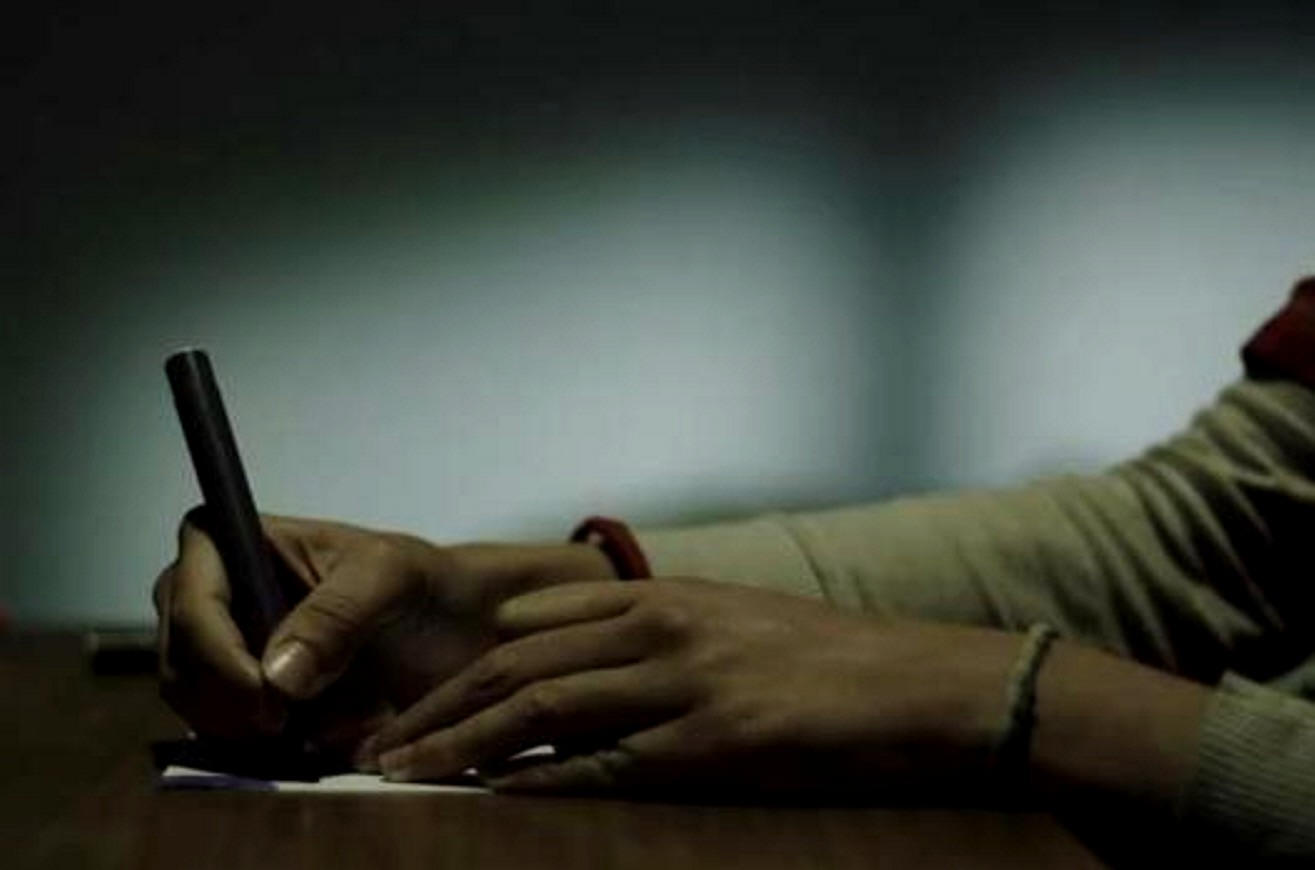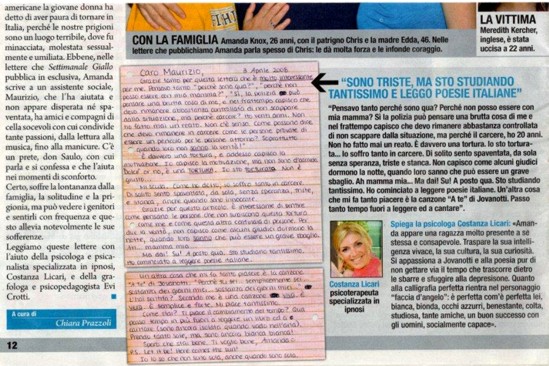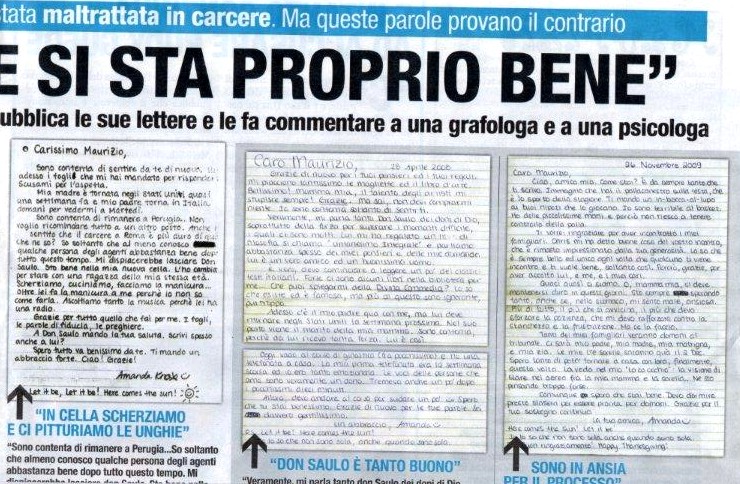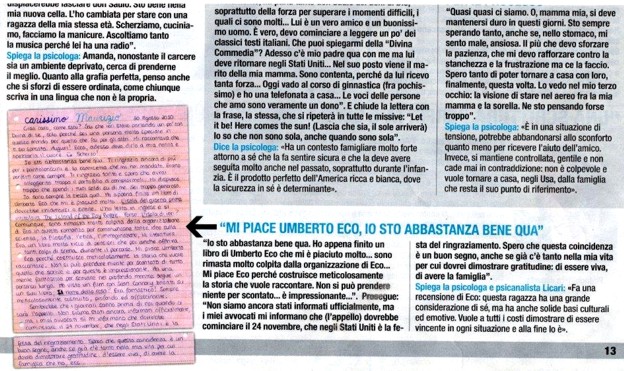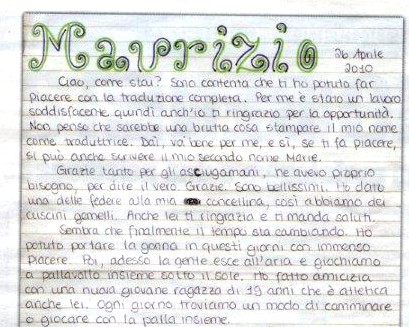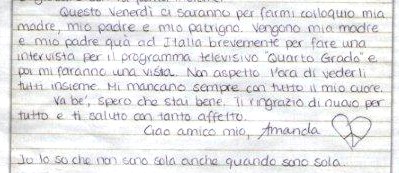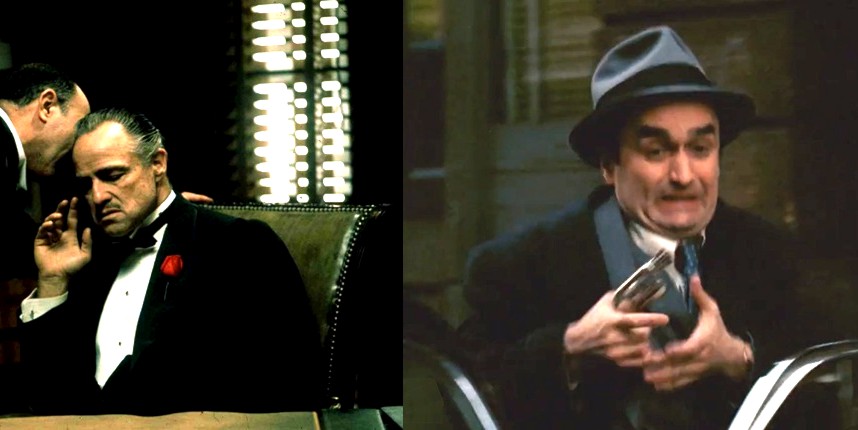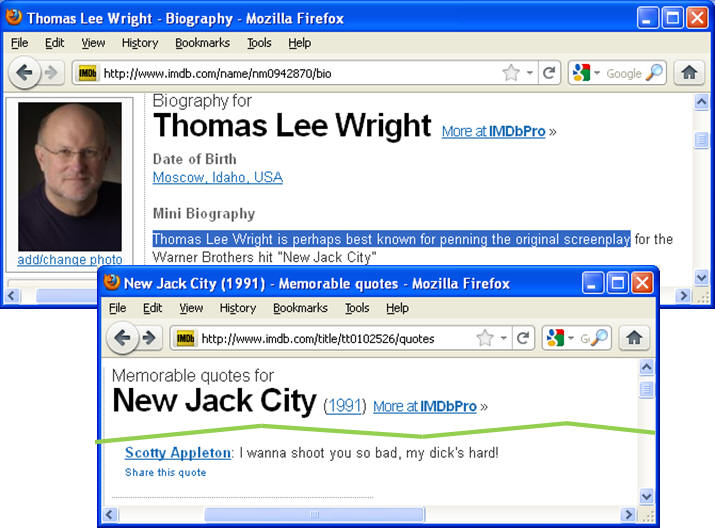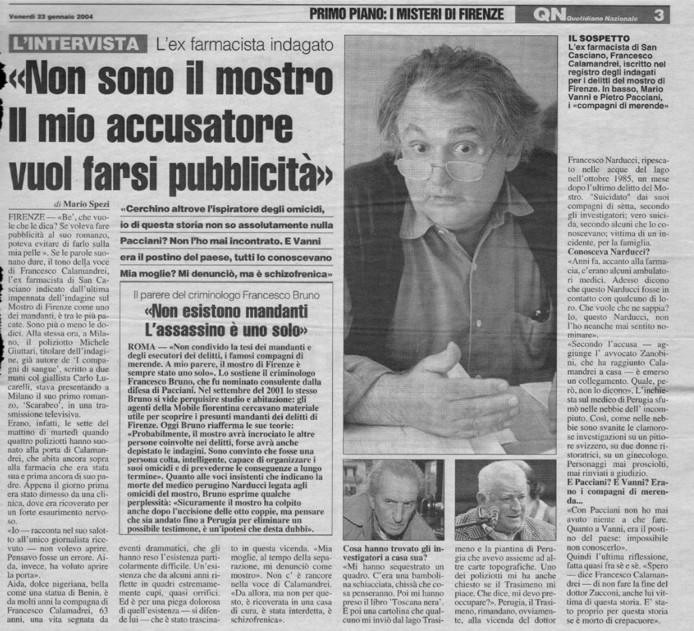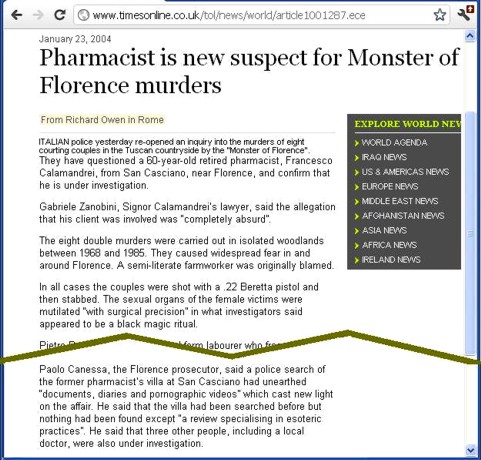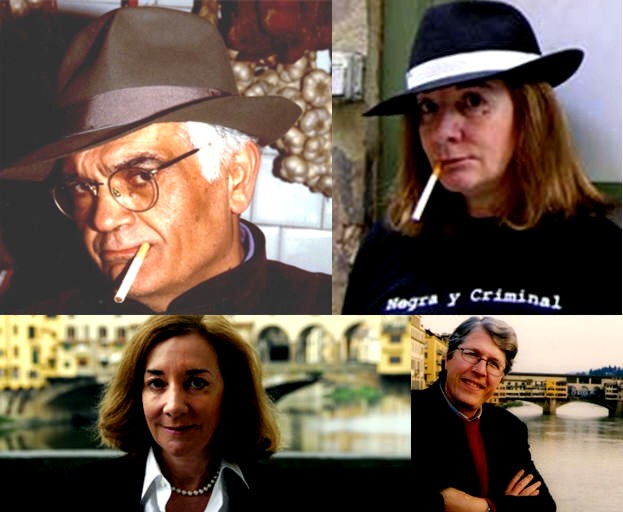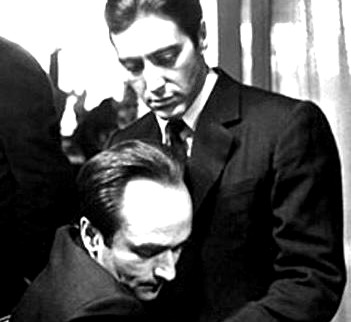
Thursday, June 20, 2013
The Florence Palace Of Justice Where Sollecito And Knox Are Expected To Be Seen In Court Soon
Posted by Peter Quennell
This is a video of a recent light show. The soundtrack leaves something to be desired, but the huge new courthouse looks amazing at night.
We posted previously here on the new Palazzio di Giustizia, which is one of Europe’s largest and most modern. It only came into full operation this year.
It is reported today in UK newspapers that Knox and Sollecito have just been having a meeting in the vicinity of New York, maybe to sort out a common narrative once and for all. Our betting is that each will appear in the Florence court, not least to keep a close eye on the other and to attempt to warm the judges to themselves.
However, their nasty and dishonest books have not made things any easier for them, and have led to a lot of negative reaction in Italy where they have been discussed on TV. It is easy to spot where in many places the two texts conflict, and also where (as demonstrated in the two post below) they also contradict many accepted well-documented facts of the case.
Both books are being considered as substantial new evidence, and the prosecution will ask the appeal court if they can be included in.
Both books are also being investigated, by the chief prosecutors in Florence and Bergamo for separate new felony charges, as they appear to constitute substantial lllegal attempts along with the internet vilification posted by the likes of Preston, Fischer and the Moores, to inflame and mislead public opinion during an ongoing legal process.
The writers have also sought to undermine the officers of the court, by accusing them of serious crimes, again as illustrated in the two posts directly below. Many Italians and Americans with “relevant information” could be called to testify for the prosecution or the defenses. They will probably be asked to explain their own inflammatory campaigns and may face charges of their own. Again, Preston, Fischer and the Moores seem to have painted targets on their backs.
Results of both investigations, together with any new charges against Sollecito, Knox, and their entourages, should be made public well before the new appeal of Meredith’s case gets under way.
If the two are indicted on new charges for the books, as expected, that will mean more to explain, more to try to harmonize upon, more goodwill lost, and more legal bills.
If their Italian lawyers recklessly promoted these daft projects, as texts in the books themselves suggest, the lawyers could all face both contempt of court charges and malpractice suits from their clients.
Nice work….
Sunday, June 16, 2013
Questions For Knox: Do You Really Think “False Memories” Claim Framing Italians Yet Again Will Help?
Posted by Our Main Posters
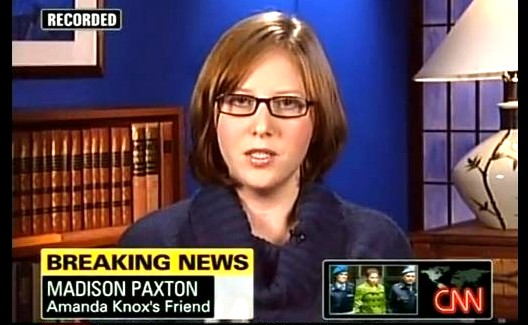
[You say Madison Paxton found Kassin? So why did Bruce Fischer and Sarah claim to have done so??]
1. Your Real Persona, Widely Observed
Remember that Italians have seen a lot more of the real you than most Americans ever have. Italians all saw the real you described here and here.
That is why maybe 95% of all Italians long ago concluded for your guilt. At times you can come across as winning but, as there on the stand, too often as brash, sneering, sharp-elbowed, humorless, uncaring, and self-absorbed.
That is the Knox that put off many who encountered you in Seattle, it is why you had Halloween largely alone, and why you put off almost everyone you encountered in Perugia. Including everyone in your house in Perugia, and most in Patrick’s bar - and this literally in less than a month.
The “lost little girl” persona, the “chaste girl who never did sex and drugs” persona, the “diligent girl who studied so hard” persona, and the “they all want to get me because I am so fantastically cute” persona you or your agenda-driven shadow-writer put in the book have many people who have seen a lot of you in strong disbelief.
Can you name even one good friend who still stands by you in Perugia, given that even Raffaele Sollecito has placed you at the brink of a cliff?
By the way, this is not an unkind group, mostly comprised as it is of professionals, and some surprising things you yourself said in your book confirmed a suspicion about untreated root causes that we mentioned here.
2. Pages 270 to 272 Of Your Book With Your False Claims Highlighted
Let us first quote what you claim about your interrogation as “explained” by Saul Kassin who had at this point diagnosed you only long-distance and talked with not even one person who was there. False claims are shown in bold.
Thankfully Madison had researched the science on false confessions. She found Saul Kassin, a psychologist at John Jay College of Criminal Justice in New York. A specialist in wrongful convictions, he took the mystery out of what had happened to me.
Before my interrogation, I believed, like many people, that if someone were falsely accused, they wouldn’t, couldn’t, be swayed from the truth while under interrogation. I never would have believed that I could be pressured into confessing to something I hadn’t done. For three years I berated myself for not having been stronger. I’m an honest person. During that interrogation, I had nothing to hide, and a stake in the truth “” I desperately wanted the police to solve Meredith’s murder. But now I know that innocent people often confess. The records kept of people convicted of a crime and later exonerated by DNA evidence show that the DNA of 25 percent of them didn’t match the DNA left at the scene. The DNA testing showed that one in four innocent people ended up confessing as I did. And experts believe that even more innocent people confess, both in cases with and without DNA evidence.
According to Kassin, there are different types of false confessions. The most common is “compliant,” which usually happens when the suspect is threatened with punishment or isolation. The encounter becomes so stressful, so unbearable, that suspects who know they’re innocent eventually give in just to make the uncomfortably harsh questioning stop. “You’ll get thirty years in prison if you don’t tell us,” says one interrogator. “I want to help you, but I can’t unless you help us,” says another.
This was exactly the good cop/bad cop routine the police had used on me.
Besides being compliant, I also showed signs of having made an “internalized” false confession. Sitting in that airless interrogation room in the questura, surrounded by people shouting at me during forty-three hours of questioning over five days, I got to the point, in the middle of the night, where I was no longer sure what the truth was. I started believing the story the police were telling me. They took me into a state where I was so fatigued and stressed that I started to wonder if I had witnessed Meredith’s murder and just didn’t remember it. I began questioning my own memory.
Kassin says that once suspects begin to distrust their own memory, they have almost no cognitive choice but to consider, possibly accept, and even mentally elaborate upon the interrogator’s narrative of what happened. That’s how beliefs are changed and false memories are formed.
That’s what had happened to me.
I was so confused that my mind made up images to correspond with the scenario the police had concocted and thrust on me. For a brief time, I was brainwashed.
Three years after my “confession,” I’d blocked out some of my interrogation. But the brain has ways of bringing up suppressed memories. My brain chooses flashbacks””sharp, painful flashes of memory that flicker, interrupting my conscious thoughts. My adrenaline responds as if it’s happening in that moment. I remember the shouting, the figures of looming police officers, their hands touching me, the feeling of panic and of being surrounded, the incoherent images my mind made up to try to explain what could have happened to Meredith and to legitimize why the police were pressuring me.
This new knowledge didn’t stop my nightmares or flashbacks, but I was so relieved to learn that what I’d been through wasn’t unique to me. It had been catalogued! It had a name! As soon as I understood that what happened during my interrogation wasn’t my fault, I started forgiving myself.
Kassin and others show that interrogations are intentionally designed to bewilder and deceive a suspect. Originally created to get highly trained, patriotic U.S. fighter pilots to sell out their country during the Korean War, one technique uses a tag team of investigators and tactics meant to induce exhaustion, agitation, and fear. It’s especially potent on young, vulnerable witnesses like me. The method was designed not to elicit information but to plant it “” specifically tailored to destroy an orderly thought process. After some hours, the subject gives the interrogators what they want “” whether it’s the truth or not.
In my case they’d put several interrogators in a room with me. For hours they yelled, screamed, kept me on edge. When they exhausted themselves, a fresh team replaced them. But I wasn’t even allowed to leave to use the bathroom.
These were strategic measures, many of which are described in Kassin’s report on police interrogation, “On the Psychology of Confessions: Does Innocence Put Innocents at Risk?” Reading it, I was flabbergasted to learn how by the book the police had been in their manipulation of me.
It had been the middle of the night. I’d already been questioned for hours at a time, days in a row. They tried to get me to contradict myself by homing in on what I’d done hour by hour, to confuse me, to cause me to lose track and get something wrong. They said I had no alibi. They lied, saying that Raffaele had told them I’d asked him to lie to the police. They wouldn’t let me call my mom. They wouldn’t let me leave the interrogation room. They were yelling at me in a language I didn’t understand. They hit me and suggested that I had trauma-induced amnesia. They encouraged me to imagine what could have happened, encouraged me to “remember” the truth because they said I had to know the truth. They threatened to imprison me for thirty years and restrict me from seeing my family. At the time, I couldn’t think of it as anything but terrifying and overwhelming.
That was exactly their point.
Highlighted in bold is another large body of your many easy-to-disprove lies as in the previous post.
Your bizarre analysis leads to many many questions.
- What honest person? You served three years for felony lying. Exactly how did you ever help the police? What good cop/bad cop routine? There were only ever 2 or 3 interviewers there. What airless room? You were in a very modern building with air conditioning. What shouting? What 43 hours of interrogation? You had at most been questioned for one or two hours - and only for a few minutes on this night when you “broke”. What story were police forcing on you? Why were you so confused and stressed - other than that Sollecito had just left you with no alibi? What did the police concoct and thrust on you, and why? Why didnt they do that to anyone else? So many others were interviewed too.
You are not even in Kassin’s “vulnerable” target group. How could you possibly be brainwashed in such a short time? What do you mean “after some hours”? What hours? Who exactly yelled and screamed and kept you on edge? What fresh tag team? Who stopped you leaving the interrogation room for a bathroom break? Why did you testify that you were given refreshments and treated well? Why did your own lawyers say you were treated well? Why did they never lodge a complaint? Why when you had an excellent interpreter did you say you couldn’t understand? Why would police threaten to imprison you for 30 years when their whole interest moved quickly to Patrick as you engineered? And why after the interview when you were left sitting in a corridor, babbling and being calmed down, did you not simply walk right out?
In fact, nobody ever accused you of anything at all in your voluntary witness interview.
You were put under no pressure to confess. Not so long after Sollecito fingered you, you spontaneously blamed Patrick for Meredith’s death. For the next several hours, you babbled on, again and again blaming Patrick. Dr Mignini then witnessed you being warned, and barely said a word.
And of course you never ever did confess that you participated in the attack on Meredith yourself. You are really claiming a false confession - when you didnt even confess?
Sollecito similarly cracked spontaneously in an adjacent room, and he pointed the blame at you. Its very noticeable in all of the above that you essentially dont even mention his name. Nor does Kassin.
So what made Sollecito crack? You don’t explain that.
3. Saul Kassin’s Version with His False Claims Highlighted
It seems that Kassin was subjected to the toxic Misinformation Cloud conjured up by the Rank Amateurs for Knox, and Kassin very foolishly failed to check with anyone at all who had been on the spot.
Here are the relevant passages from Saul Kassin’s paper in American Psychologist with his false claims highlighted in bold.
As illustrated by the story of Amanda Knox and many others wrongfully convicted, false confessions often trump factual innocence. Focusing on consequences, recent research suggests that confessions are powerfully persuasive as a matter of logic and common sense; that many false confessions contain richly detailed narratives and accurate crime facts that appear to betray guilty knowledge; and that confessions in general can corrupt other evidence from lay witnesses and forensic experts””producing an illusion of false support. This latter phenomenon, termed “corroboration inflation,” suggests that pretrial corroboration requirements as well as the concept of “harmless error” on appeal are based on an erroneous presumption of independence among items of evidence. In addition to previously suggested reforms to police practices that are designed to curb the risk of false confessions, measures should be taken as well to minimize the rippling consequences of those confessions….
Meredith Kercher was found raped and murdered in Perugia, Italy. Almost immediately, police suspected 20-year-old Amanda Knox, an American student and one of Kercher’s roommates””the only one who stayed in Perugia after the murder. Knox had no history of crime or violence and no motive. But something about her demeanor””such as an apparent lack of affect, an outburst of sobbing, or her girlish and immature behavior”” led police to believe she was involved and lying when she claimed she was with Raffaele Sollecito, her new Italian boyfriend, that night.
Armed with a prejudgment of Knox’s guilt, several police officials interrogated the girl on and off for four days. Her final interrogation started on November 5 at 10 p.m. and lasted until November 6 at 6 a.m., during which time she was alone, without an attorney, tag-teamed by a dozen police, and did not break for food or sleep. In many ways, Knox was a vulnerable suspect””young, far from home, without family, and forced to speak in a language in which she was not fluent. Knox says she was repeatedly threatened and called a liar. She was told, falsely, that Sollecito, her boyfriend, disavowed her alibi and that physical evidence placed her at the scene. She was encouraged to shut her eyes and imagine how the gruesome crime had occurred, a trauma, she was told, that she had obviously repressed. Eventually she broke down crying, screaming, and hitting herself in the head. Despite a law that mandates the recording of interrogations, police and prosecutors maintain that these sessions were not recorded.
Two “confessions” were produced in this last session, detailing what Knox called a dreamlike “vision.” Both were typed by police””one at 1:45 a.m., the second at 5:45 a.m. She retracted the statements in a handwritten letter as soon as she was left alone (“In regards to this “˜confession’ that I made last night, I want to make it clear that I’m very doubtful of the verity of my statements because they were made under the pressures of stress, shock, and extreme exhaustion.”). Notably, nothing in the confessions indicated that she had guilty knowledge. In fact, the statements attributed to Knox were factually incorrect on significant core details (e.g., she named as an accomplice a man whom police had suspected but who later proved to have an ironclad alibi; she failed to name another man, unknown to police at the time, whose DNA was later identified on the victim). Nevertheless, Knox, Sollecito, and the innocent man she implicated were all immediately arrested. In a media-filled room, the chief of police announced: Caso chiuso (case closed).
Police had failed to provide Knox with an attorney or record the interrogations, so the confessions attributed to her were ruled inadmissible in court. Still, the damage was done. The confession set into motion a hypothesis-confirming investigation, prosecution, and conviction. The man whose DNA was found on the victim, after specifically stating that Knox was not present, changed his story and implicated her while being prosecuted. Police forensic experts concluded that Knox’s DNA on the handle of a knife found in her boyfriend’s apartment also contained Kercher’s blood on the blade and that the boyfriend’s DNA was on the victim’s bra clasp. Several eyewitnesses came forward. An elderly woman said she was awakened by a scream followed by the sound of two people running; a homeless drug addict said he saw Knox and Sollecito in the vicinity that night; a convicted drug dealer said he saw all three suspects together; a grocery store owner said he saw Knox the next morning looking for cleaning products; one witness said he saw Knox wielding a knife.
On December 5, 2009, an eight-person jury convicted Amanda Knox and Raffaele Sollecito of murder. The two were sentenced to 26 and 25 years in prison, respectively. Finally, on October 3, 2011, after having been granted a new trial, they were acquitted. [Actually they still stand accused - and facing a tough fact-based prosecution appeal] Ten weeks later, the Italian appeals court released a strongly worded 143-page opinion in which it criticized the prosecution and concluded that there was no credible evidence, motive, or plausible theory of guilt. For the four years of their imprisonment, this story drew international attention (for comprehensive overviews of the case, see Dempsey, 2010, and Burleigh, 2011).1
It is now clear that the proverbial mountain of discredited evidence used to convict Amanda Knox and Raffaele Sollecito was nothing but a house of cards built upon a false confession. The question posed by this case, and so many others like it, is this: Why do confessions so often trump innocence? ...
Third, it is important to realize that not all evidence is equally malleable or subject to corroboration inflation. Paralleling classic research indicating that expectations can color judgments of people, objects, and other stimuli that are ambiguous as opposed to those that compel a particular perception, forensic research indicates that ambiguity is a moderating condition. Asked to report on an event or make an identification decision on the basis of a memory trace that cannot be recovered, eyewitnesses are particularly malleable when confronted with evidence of a confession (Hasel & Kassin, 2009). This phenomenon was illustrated in the case against Amanda Knox. When police first interviewed Knox’s British roommates, not one reported that there was bad blood between Knox and the victim. After Knox’s highly publicized confession, however, the girls brought forth new “memories,” telling police that Kercher was uncomfortable with Knox and the boys she would bring home (Burleigh, 2011). ...
In recent years, psychologists have been critical of the problems with accuracy, error, subjectivity, and bias in various types of criminal evidence””prominently including eyewitness identification procedures, police interrogation practices, and the so-called forensic identification sciences, all leading Saks and Koehler (2005) to predict a “coming paradigm shift.” With regard to confessions, it now appears that this shift should encompass not only reforms that serve to minimize the risk of false confessions but measures designed to minimize the rippling consequences of those confessions””as in the case of Amanda Knox and others who are wrongfully convicted.
4. An Exposure Of Ten Of Saul Kassins’s False Claims
Our main poster the Machine exposes further how Kassin’s key claims are wrong.
False Claim 1: They brought her in for that final interrogation late at night.
No they didn’t.
Neither the police nor the prosecutors brought Amanda in for questioning on 5 November 2007. Amanda Knox herself testified in court that she wasn’t called to come to the police station on 5 November 2007.
Carlo Pacelli: “For what reason did you go to the Questura on November 5? Were you called?”
Amanda Knox: “No, I wasn’t called. I went with Raffaele because I didn’t want to be alone.”
Amanda Knox went with Raffaele Sollecito because she didn’t want to be alone. Kassin’s false claim is the first red flag that Saul Kassin is very confused or has been seriously misled when it comes to this well-documented and well-handled case.
False Claim 2: The so-called confession wasn’t until 6:00am.
No it wasn’t.
If Saul Kassin had actually read Amanda Knox’s first witness statement, he would have known that it was made at 1:45am. Knox had admitted that she was at the cottage when Meredith was killed some time before this.
False Claim 3: She was interrogated from 10:00pm to 6.00am.
No she wasn’t.
According to the Daily Beast Amanda Knox’s questioning began at about 11:00pm.
Since Knox was already at the police station [in the company of Raffaele Sollecito] the head of the murder squad decided to ask her a few questions. Her interrogation started at about 11 p.m.
After Amanda Knox had made her witness statement at 1:45am, she wasn’t questioned again that evening. That was it.
However, Amanda Knox herself then wanted to make further declarations and Mr Mignini who was on duty on the night sat and watched while Knox wrote out her declarations.
Mr Mignini explained what happened in his email letter to Linda Byron, another who was factually challenged.
All I did was to apply the Italian law to the proceedings. I really cannot understand any problem.
In the usual way, Knox was first heard by the police as a witness, but when some essential elements of her involvement with the murder surfaced, the police suspended the interview, according to Article 63 of the penal proceedings code.
But Knox then decided to render spontaneous declarations, that I took up without any further questioning, which is entirely lawful.
According to Article 374 of the penal proceedings code, suspects must be assisted by a lawyer only during a formal interrogation, and when being notified of alleged crimes and questioned by a prosecutor or judge, not when they intend to render unsolicited declarations.
Since I didn’t do anything other than to apply the Italian law applicable to both matters, I am unable to understand the objections and reservations which you are talking about.
In Amanda Knox’s written witness statement, she explicitly states that she’s making a spontaneous declaration:
Amanda Knox: “I wish to relate spontaneously what happened because these events have deeply bothered me and I am really afraid of Patrick, the African boy who owns the pub called “Le Chic” located in Via Alessi where I work periodically.
False Claim 4: They banged her on the back of the head.
No they didn’t.
All the numerous witnesses who were actually present when Amanda Knox was questioned, including her interpreter, testified under oath at trial in 2009 that she wasn’t hit. She has never identified anyone who hit her and on several occasions confirmed that she was treated well.
Even one of Amanda Knox’s lawyers, Luciano Ghirga, confirmed that Amanda Knox had not been hit: “There were pressures from the police but we never said she was hit.” He never ever lodged a complaint.
False Claim 5: All the other British roommates left town.
No they didn’t.
The police also told Sophie Purton that they needed her to stay on in Perugia on precisely the same basis as Amanda Knox. In chapter 19 of Death in Perugia, John Follain states that Sophie Purton was questioned by Mignini and Napoleoni in the prosecutor’s office on 5 November 2007.
Sophie had been counting on leaving Perugia to fly back home as soon as her parents arrived, but the police called to tell her they needed her to stay on; they would let her know when she could leave.
False Claim 6 : Amanda Knox stayed back to help the police.
No she didn’t.
This claim is flatly contradicted by Amanda Knox herself. In the e-mail she wrote to her friends in Seattle on 4 November 2007 she categorically stated she was not allowed to leave Italy.
i then bought some underwear because as it turns out i wont be able to leave italy for a while as well as enter my house
Knox actually knew on 2 November 2007 that she couldn’t leave Italy. Amy Frost reported the following conversation (The Massei report, page 37),
I remember having heard Amanda speaking on the phone, I think that she was talking to a member of her family, and I heard her say, No, they won’t let me go home, I can’t catch that flight.
It’s not the first time that the myth that Knox chose to stay behind rather than leave Italy has been claimed in the media. And incidentally, lying repeatedly to the police isn’t normally considered to be helping them.
False Claim 7: Amanda Knox had gone 8 hours without any food or drink.
No she hadn’t.
Reported by Richard Owen in The Times, 1 March 2009
Ms Napoleoni told the court that while she was at the police station Ms Knox had been ‘treated very well. She was given water, camomile tea and breakfast. She was given cakes from a vending machine and then taken to the canteen at the police station for something to eat.’
Reported by Richard Owen in The Times, 15 March 2009.
Ms Donnino said that Ms Knox had been “comforted” by police, given food and drink, and had at no stage been hit or threatened.
John Follain in his meticulous book Death in Perugia, page 134, also reports that Knox was given food and drink during her questioning:
During the questioning, detectives repeatedly went to fetch her a snack, water, and hot drinks including camomile tea.
False Claim 8: The translator was hostile towards Amanda Knox.
No she wasn’t.
Saul Kassin offers no evidence that the translator was hostile towards Amanda Knox and there is no evidence that this was the case. Nobody at the questura has claimed this. Amanda Knox’s own lawyers have not claimed this.
Even Amanda Knox herself has never ever claimed that Anna Donnino was hostile towards her although she had every opportunity to do so when being questioned on the stand.
False Claim 9: The translator was acting as an agent for the police.
No she wasn’t.
Saul Kassin offers no evidence to support this claim, which by the way in Italy is the kind of unprofessional charge that incurs calunnia suits. Do ask Curt Knox.
False Claim 10: The police lied to Amanda Knox.
No they didn’t.
The police didn’t mislead Amanda Knox. They told her quite truthfully that Sollecito was no longer providing her with an alibi, and that he had just claimed in the next interrogation room that she wasn’t at his apartment from around 9:00pm to about 1:00am. This also is the kind of unprofessional charge that incurs calunnia suits
Other claims by Kassin are also inaccurate. He claims that not one of your acquaintances had reported there was bad blood. That also is untrue. Even prior to the witness interrogation, law enforcement knew from multiple sources that you had been feuding with just about everyone. Acquaintances created no “new memory”. The bad blood you created was quite real.
5. How Kassin Bends His Own Science To Make Results Come Out “Right”
Our main poster Fuji dug deeper into the science and turns up what is an obvious scientific fraud by Kassin to insert himself into the case.
Meredith’s case is absolutely riddled with fabricated false myths.
They are now found by the hundreds on some misleading websites, and they simply make experienced law enforcement and criminal lawyers laugh.
For example “Police had no good reason to be immediately suspicious of Knox simply because the murder occurred at her residence”. And “The double-DNA knife is a priori to be disregarded as evidence, because no murderer would retain possession of such a murder weapon.”
One of the most strident and widespread myths is that Amanda Knox’s statements to the Perugian investigators on 5 and 6 November 2007, placing her at the scene of Meredith’s murder, are to be viewed as the products of a genuinely confused mind imbued with a naïve trust of authority figures.
The apparent certainty with which many of Amanda Knox’s most vocal supporters proclaim that Knox’s statements are actual “false confessions” as opposed to deliberate lies is not supported by even a cursory reading of the pertinent academic literature regarding false confessions.
What actually are “false confessions”?
Richard N. Kocsis in his book “Applied Criminal Psychology: A Guide to Forensic Behavioral Sciences” (2009), on pages 193-4 delineates three different kinds of false confessions:
First, a voluntary false confession is one in which a person falsely confesses to a crime absent any pressure or coercion from police investigators….
Coerced-compliant false confessions occur when a person falsely confesses to a crime for some immediate gain and in spite of the conscious knowledge that he or she is actually innocent of the crime….
The final type, identified by Kassin and Wrightsman (1985), is referred to as a coerced-internalized false confession. This occurs when a person falsely confesses to a crime and truly begins to believe that he or she is responsible for the criminal act.
The first problem facing Knox supporters wishing to pursue the false confession angle as a point speaking to her purported innocence is epistemological.
Although much research has been done on this phenomenon in recent years, academics are still struggling to come to terms with a methodology to determine their incidence rate.
The current state of knowledge does not support those making sweeping claims about the likelihood of Knox’s statements being representative of a genuine internalized false confession.
As noted by Richard A. Leo in “False Confessions: Causes, Consequences, and Implications” (Journal of the American Academy of Psychiatry and the Law, 2009):
Although other researchers have also documented and analyzed numerous false confessions in recent years, we do not know how frequently they occur. A scientifically meaningful incidence rate cannot be determined for several reasons.
First, researchers cannot identify (and thus cannot randomly sample) the universe of false confessions, because no governmental or private organization keeps track of this information.
Second, even if one could identify a set of possibly false confessions, it is not usually possible as a practical matter to obtain the primary case materials (e.g., police reports, pretrial and trial transcripts, and electronic recordings of the interrogations) necessary to evaluate the unreliability of these confessions.
Finally, even in disputed confession cases in which researchers are able to obtain primary case materials, it may still be difficult to determine unequivocally the ground truth (i.e., what really happened) with sufficient certainty to prove the confession false.
In most alleged false-confession cases, it is therefore impossible to remove completely any possible doubts about the confessor’s innocence.
The next problem Knox supporters face is that, even allowing for an inability to establish a priori any likelihood of a given statement being a false confession, the kind of false confession which is usually attributed to Knox is in fact one of the LEAST likely of the three types (Voluntary, Compliant, and Persuaded, as Leo terms the three different categories) to be observed:
Persuaded false confessions appear to occur far less often than compliant false confessions.
Moreover, despite assertions to the contrary, Knox and her statements do not in fact satisfy many of the criteria researchers tend to observe in false confessions, particularly of the Persuaded variety:
“All other things being equal, those who are highly suggestible or compliant are more likely to confess falsely. Individuals who are highly suggestible tend to have poor memories, high levels of anxiety, low self-esteem, and low assertiveness, personality factors that also make them more vulnerable to the pressures of interrogation and thus more likely to confess falsely…
Highly suggestible or compliant individuals are not the only ones who are unusually vulnerable to the pressures of police interrogation. So are the developmentally disabled or cognitively impaired, juveniles, and the mentally ill….
They also tend to occur primarily in high-profile murder cases and to be the product of unusually lengthy and psychologically intense interrogations… ordinary police interrogation is not strong enough to produce a permanent change in the suspect’s beliefs.
Most significantly, there is one essential element of a true Persuaded False Confession which in Knox’s case is highly distinctive:
To convince the suspect that it is plausible, and likely, that he committed the crime, the interrogators must supply him with a reason that satisfactorily explains how he could have done it without remembering it.
This is the second step in the psychological process that leads to a persuaded false confession.
Typically, the interrogator suggests one version or another of a “repressed” memory theory.
He or she may suggest, for example, that the suspect experienced an alcohol- or drug-induced blackout, a “dry” blackout, a multiple personality disorder, a momentary lapse in consciousness, or posttraumatic stress disorder, or, perhaps most commonly, that the suspect simply repressed his memory of committing the crime because it was a traumatic experience for him.
The suspect can only be persuaded to accept responsibility for the crime if he regards one of the interrogators’ explanations for his alleged amnesia as plausible.
Knox did not in fact claim drug or alcohol use as the source of her amnesia - rather, she claimed to have accepted the interrogators’ attribution that this was due to being traumatized by the crime itself, and she offers no other explanation for her selective amnesia:
This is from Knox’s statement to the court in pretrial on 18 October 2008 with Judge Micheli presiding.
Then they started pushing on me the idea that I must have seen something, and forgotten about it. They said that I was traumatized.
Of course, Knox’s initial statement went far beyond being that of being merely a witness to some aspect of Ms. Kercher’s murder, as the interrogators at first seemed to believe was the case.
Rather, her statement placed her at scene of the murder during its actual commission while she did nothing to avert it, which naturally made her a suspect.
In other words, in the absence of any of her other testimony which indicated that she was only a witness to the murder, her own self-admitted rationale for providing a false confession was that she was traumatized by the commission of the murder itself.
Perugia judges will be familiar with all of the above and we can be sure that they brief the lay judges on the remote circumstances and incidences of false confessions.
If I were a Knox defense attorney, I would find it to be a far more fruitful line of argumentation to argue that she was simply lying, rather than claiming the supremely unlikely provision of an actual internalized false confession.
6. Kassin’s Paper with Correct Facts and Context Now Included
Here is our main poster BR Mull describing what actually took place.
On November 2, 2007, British exchange student Meredith Kercher was found sexually attacked and murdered in Perugia, Italy. The next day, 20-year-old Amanda Knox, an American student and one of Kercher’s roommates, became a person of interest, along with Meredith’s downstairs neighbors and several of her other acquaintances. Interviewing close contacts is a cornerstone of police work. Two of Meredith’s close English friends, who were so scared they couldn’t sleep alone, left Perugia in the immediate aftermath of the murder. Everyone else stayed on.
Months before arriving in Perugia, Knox received a citation for a noise violation when a going-away party she’d thrown for herself in Seattle got out of hand. One of the officers described it as a “scene from Baghdad.” Within about three weeks of moving into the cottage in Perugia, Knox was ejected from a nightclub for pouring her glass on the head of a disc jockey.
It’s often said that Knox had no motive to kill Meredith, but it was Knox’s claim of drug use which indicated a possible motive: a drug-fuelled assault. There are various others, though a motive is not actually required for conviction. In crime scene videos from the day Meredith’s body was discovered, Knox can be seen outside the cottage glancing furtively around. Still, it was not this and other odd behavior, but rather the many conflicting witness statements by Knox and her new Italian boyfriend, Raffaele Sollecito, that led police to believe Knox was involved and lying when she claimed she was with Sollecito at his home continuously on the night of November 1.
Police interviewed dozens of witnesses in the days after the murder, some more than once. All witness statements were written down and signed for, not recorded. The police interviewed Sollecito for the third time beginning at 10:40pm on November 5. Knox later testified that she voluntarily accompanied her boyfriend to the station, because she didn’t want to be alone. The police did not summon her. To the interviewers’ surprise, Sollecito repudiated his earlier alibi when shown phone records, and now said Knox had left his apartment for much of the evening. Some time after 11:00pm the police asked if they might interview Knox. An interpreter was called and by 1:45am Knox had given a signed statement that she had witnessed the sounds of her employer, bar owner Patrick Lumumba, murdering Meredith at the cottage.
In that statement she acknowledged that she had been given an interpreter, and that she herself was now officially a suspect. Knox later testified that she was treated well. She was offered snacks and drinks during the interview and afterward. Made aware that she could not be interrogated without a lawyer, but still anxious to put out as much information as possible, she then requested a chance to make a spontaneous statement without any questioning. The prosecutor on duty agreed, and she gave a statement in front of him very similar to her witness statement from hours earlier.
Knox and the police gave different accounts of how the 11:00 to 1:45 am interview was conducted. Police said Knox was told Sollecito now no longer confirmed her alibi and he had called her a liar. She now had no alibi. Sympathetic to her because Knox now had no alibi, the interpreter urged her to try to remember at least something. Shown a text she had sent to Lumumba at 8:35pm saying “See you later. Have a good evening!” she was asked to explain this. The police say Knox started to cry and burst out, “It’s him! It’s him!”
Both Knox’s witness statement at 1:45 a.m and her voluntary suspect statement at 5:45am were written out in Italian and translated back to her before she signed. After Knox was formally taken into custody at midday on November 6, she asked for paper and wrote a slight modification of her earlier statements, adding: “In regards to this “˜confession’ that I made last night, I want to make it clear that I’m very doubtful of the verity of my statements because they were made under the pressures of stress, shock, and extreme exhaustion.”
Lumumba was arrested along with Knox and Sollecito. Knox and her mother held out on his non-involvement, but he was eventually determined to have a solid alibi. Another man, Rudy Guede, was identified through a hand print in Meredith’s bedroom. Knox appeared to have substituted Lumumba for Guede in her statements, and several details of the crime in her so-called confession were later corroborated by witnesses.
Because police had not needed to provide Knox with an attorney at the impromptu witness interview after 11:00, the Supreme Court ruled that statement inadmissible in the murder case against her. However both statements were ruled admissible in court for the purpose of establishing the crime of defamation against Patrick Lumumba. Knox’s November 6 letter was also ruled admissible.
Guede, the man whose DNA was found on the victim, told a friend while he was still on the run that he had found Meredith stabbed and that Knox had nothing to do with the murder. However, in the same conversation, which was recorded by police, he speculated that Knox and Sollecito might have been at the cottage. In a letter dated March 7, 2010, while his sentence was awaiting final confirmation by the Supreme Court, Guede wrote that Knox and Sollecito murdered Meredith. He reiterated this claim as a witness during Knox and Sollecito’s appeal.
Forensic police from Rome concluded that a kitchen knife found in Sollecito’s apartment had Knox’s DNA on the handle and Meredith’s DNA on the blade. Sollecito’s DNA was on the victim’s bra clasp in Meredith’s locked bedroom.
Several eyewitnesses came forward. Three neighbors testified that they heard a disturbance around 11:30pm in the vicinity of the cottage. A homeless man who at appeal admitted heroin use was reading a newsmagazine at the basketball court near the cottage. He testified that he saw Knox and Sollecito four or five times that night. An Albanian, a possible drug dealer. who the Massei court deemed unreliable after the Micheli court accepted him, said he had seen all three suspects together, and that Knox had accosted him with a knife. A grocery store owner testified he saw Knox at his shop early on the morning after the murder.
The conflicting alibis of the two were never resolved during trial. On December 4, 2009, an eight-person panel consisting of two professional judges and six lay judges found Amanda Knox and Raffaele Sollecito guilty of murder aggravated by sexual assault, simulation of a burglary, unlawful carrying of a knife and, in Knox’s case, criminal defamation of Patrick Lumumba. The two were sentenced to 26 and 25 years in prison, respectively….
Knox’s mother later described her daughter as “oblivious to the dark side of the world.” Knox herself wrote that, on the night of the murder, she and Sollecito were talking about his mother’s suicide. She told him her philosophy was “life is full of choices and that these choices are not necessarily between good and evil, but between what’s better and what’s worse.”...
7. Our Concluding Advice
You simply didnt remotely fit Kassin’s own profile of those who break easily under interrogation and make things up. Your suspect interrogation was gentle, brief and considerate, as you have said, and didnt remotely fit Kassin’s claims. And of course, you never made a false confession on that night or any other.
Do you really want this guy or yourself cross-examined on the stand? Again, it may be the last good time to try to walk all of your malicious invention back.
[Saul Kassin with President Travis of John Jay College who lets the false anti-Italy allegations stand]
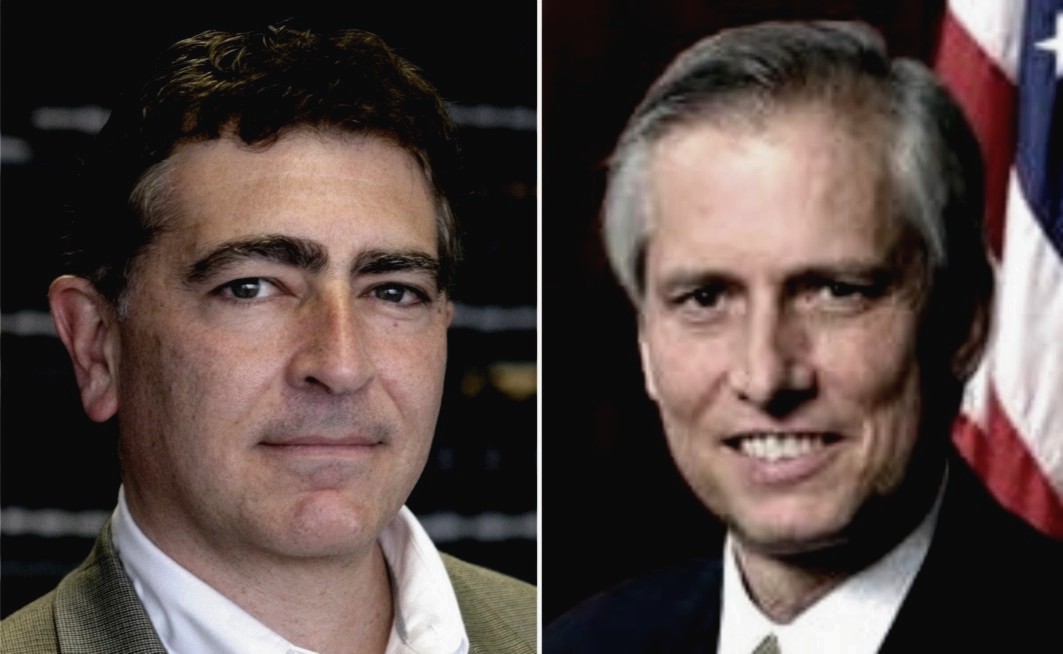
Friday, June 14, 2013
Questions For Knox: Did You Actually Undergo An Illegal Interrogation?
Posted by Our Main Posters
Yet Another Damning Question For Knox
Why exactly did you frame your kindly employer Patrick for the crime?
Even the hapless Judge Hellmann, who seemed to try so hard (at his own cost - he is now forcibly retired) to have things break your way, didn’t believe anyone ever forced or tricked you into framing Patrick for the crime.
Accordingly you served three years in Capanne Prison, and in March the Supreme Court threw out your final appeal over that. You now have a felony record for life, as well as a proven tendency to lie which every Italian knows about.
And yet you head off down the exact-same slippery slope again in so many places in your obnoxiously self-aggrandizing book. Periodically, you make easily-nailed felonious claims, as here.
Quote From The Knox Book 2013
Here on pages 90-92 you describe word for word the questioning by Prosecutor Mignini at your first (witness) interview on the night of 5-6 Nov.
[This is the voluntary witness interview.] Eventually they told me the pubblico ministero would be coming in.
I didn’t know this translated as prosecutor, or that this was the magistrate that Rita Ficarra had been referring to a few days earlier when she said they’d have to wait to see what he said, to see if I could go to Germany.
I thought the “public minister” was the mayor or someone in a similarly high “public” position in the town and that somehow he would help me.
They said, “You need to talk to the pubblico ministero about what you remember.”
I told them, “I don’t feel like this is remembering. I’m really confused right now.” I even told them, “I don’t remember this. I can imagine this happening, and I’m not sure if it’s a memory or if I’m making this up, but this is what’s coming to mind and I don’t know. I just don’t know.”
They said, “Your memories will come back. It’s the truth. Just wait and your memories will come back.”
The pubblico ministero came in.
Before he started questioning me, I said, “Look, I’m really confused, and I don’t know what I’m remembering, and it doesn’t seem right.”
One of the other police officers said, “We’ll work through it.”
Despite the emotional sieve I’d just been squeezed through, it occurred to me that I was a witness and this was official testimony, that maybe I should have a lawyer. “Do I need a lawyer?” I asked.
He said, “No, no, that will only make it worse. It will make it seem like you don’t want to help us.”
It was a much more solemn, official affair than my earlier questioning had been, though the pubblico ministero was asking me the same questions as before: “What happened? What did you see?”
I said, “I didn’t see anything.”
“What do you mean you didn’t see anything? When did you meet him?”
“I don’t know,” I said.
“Where did you meet him?”
“I think by the basketball court.” I had imagined the basketball court in Piazza Grimana, just across the street from the University for Foreigners.
“I have an image of the basketball court in Piazza Grimana near my house.”
“What was he wearing?”
“I don’t know.”
“Was he wearing a jacket?”
“I think so.”
“What color was it?”
“I think it was brown.”
“What did he do?”
“I don’t know.”
“What do you mean you don’t know?”
“I’m confused!”
“Are you scared of him?”
“I guess.”I felt as if I were almost in a trance. The pubblico ministero led me through the scenario, and I meekly agreed to his suggestions.
“This is what happened, right? You met him?”
“I guess so.”
“Where did you meet?”
“I don’t know. I guess at the basketball court.”
“You went to the house?”
“I guess so.”
“Was Meredith in the house?”
“I don’t remember.”
“Did Patrick go in there?”
“I don’t know, I guess so.”
“Where were you?”
“I don’t know. I guess in the kitchen.”
“Did you hear Meredith screaming?”
“I don’t know.”
“How could you not hear Meredith screaming?”
“I don’t know. Maybe I covered my ears. I don’t know, I don’t know if I’m just imagining this. I’m trying to remember, and you’re telling me I need to remember, but I don’t know. This doesn’t feel right.”
He said, “No, remember. Remember what happened.”
“I don’t know.”At that moment, with the pubblico ministero raining questions down on me, I covered my ears so I could drown him out.
He said, “Did you hear her scream?”
I said, “I think so.”My account was written up in Italian and he said, “This is what we wrote down. Sign it.”
Nailing Yet Another Knox Lie
So you choose to portray yourself as reluctant to talk at all? While Dr Mignini relentlessly edges you more and more into saddling Patrick with the blame? While you have no lawyer there?
In fact as you well know every word of that dialogue is made up. You invented all of it. Dr Mignini was not even there. Right then, he was asleep in bed.
Now we contrast this malicious figment of your imagination with the account of that night by many others who were present at various times. Even you yourself essentially agreed to this narrative at trial, with the one exception of an invented clip on the head.
1. You insist on being around in the central police station despite being grumpy and tired while Sollecito helps investigators to check a few claims.
2. After a while an investigator, Rita Ficarra, politely invites you to help build a list of names of men who might have known Meredith or the house. She is somewhat reluctantly as it was late and no interpreter was on hand. You quite eagerly begin. An interpreter is called from home. You calmly produce seven names and draw maps.
3. Sollecito breaks sudenly and unexpectedly early in his own recap/summary session when confronted with phone records which showed he had lied. He quickly points the finger at you as the one having made him lie. You are not told this but the investigators all know.
4. You share your phone, and break explosively when an outgoing text shows up on your phone after you had claimed you sent none. You yell out words to the effect that Patrick is the one, he killed Meredith. Police did not even know of the existence of Patrick before you identified the text as to him.
5. Thereafter you talk your head off, explaining how you had overheard Patrick attack Meredith at your house. The three ladies present and one man do what they can to calm you down. But you insist on a written statement, implicating him, and stating you went out from Sollecito’s alone.
6. This from about 2:00 am is the state of play. You are taken to the bar for refreshments and helped to sleep. You testify at trial that you were given refreshments, and everybody treated you well.
7. As you had admitted being at the scene of a crime you had not reported, you had in effect admitted to a crime, so a legal Miranda-type caution is required saying the signee understands they should not talk without a lawyer, and if they do talk that can be used as evidence in court.
8. Dr Mignini, the on-call duty prosecutor for that night, is by multiple accounts including your own at trial, not present at that list-building session with Rita Ficarra, and in fact knows nothing about it until Rita Ficarra closes it down. He comes from home.
9. Dr Mignini reads you your rights. You now sign acknowledging you know you should not talk unless your lawyer is there. Dr Mignini asks you no questions. He is anxious to get the session over so he can get on to the task of pulling Patrick in. You yourself insist on a new written statement and shrug off a lawyer. Though you are again warned, you push on.
10. Under Italian law that second statement could and should have been used against you, but the Supreme Court denied its use except against the false charges made about Patrick. Dr Mignini has said he think that was wrong in law but did not appeal.
Really a very simple chain of events, which was attested to at trial by all of those who had been present on the night, even including yourself.
There are no signs at all in anyone else’s description that you were leaned on by anybody, and nobody at the central police station had the slightest vested interest in making you into a target that night.
So where precisely does this new claim in your book of an illegal interrogation by Dr Mignini fit in? Now would be a good time to admit that you made it all up.
Saturday, June 08, 2013
Questions For Sollecito: Can You Realistically Account For The Bathroom Mat Evidence?
Posted by Our Main Posters
1. Your Attempted Bath Mat Hoax
Let us start this series of questions to you with the bloody bathmat footprint
Specifically how you characterized it at different points in your book as part of your attempted proof that Guede acting alone did the crime.
Here is the full extent of your hoax “proving” that that print was actually from Rudy Guede’s foot.
(a) [Page X11] The intruder was quickly identified as Rudy Guede, an African immigrant living in Perugia with a history of break-ins and petty crimes. His DNA was found all over Meredith’s room, and footprints made in her blood were found to match his shoes. Everything at the crime scene pointed to a lone assailant, and a single weapon. Guede repeatedly broke into houses by throwing a rock through a window, as happened here
(b) [page 23] Amanda went ahead with her shower, only to notice a small bloodstain on one of the washbasin taps. It looked like menstrual blood. Was Meredith, who shared the bathroom with her, having some sort of problem? It was unlike her to leave things less than immaculate. Maybe she’d run out to a pharmacy. Then again, it was just one small stain; perhaps she missed it.
(c) [Page 79] When my defense team examined the official paperwork, they noticed that the analysis of the footprints"including extensive inquiry into the length and shape of the foot likely to have produced them"had been conducted by two members of the Polizia Scientifica in Rome, working not in their official capacity but as private consultants charging thousands of euros to Mignini’s office. One of the analysts, Lorenzo Rinaldi, was a physicist, not a specialist in anatomy, and the other, Pietro Boemia, was a fingerprint technician with no further scientific credentials. That begged the question: if Mignini’s office felt it needed to contract the job out to private consultants, why wouldn’t it go to people with more pertinent qualifications? The whole thing stank.
(d) [page 192] We didn’t bother to ask for a review of the footprint analysis by Rinaldi and Boemia because we had demonstrated some elementary measuring errors and felt confident that would suffice.
2. Our Analyses Of The Bath Mat Print
(1) Our main poster the Machine
The Machine described at the time how the prosecution and their witnesses did a terrific job on this evidence at trial in May 2009, and how your defense had virtually no comeback at all.
Two bloody footprints were attributed to Raffaele Sollecito. One of them was revealed by luminol in the hallway, and the other one was easily visible to the naked eye on the blue bathmat in Meredith’s and Knox’s shared bathroom.
Lorenzo Rinaldi excluded the possibility that the bloody footprint on the blue bathmat was the right size or shape to belong to Knox or Guede instead of Sollecito: “You can see clearly that this bloody footprint on the rug does not belong to Mr. Guede, but you can see that it is compatible with Sollecito.”
Andrea Vogt’s report for the Seattle Post-Intelligencer shows just how meticulous and painstakingly detailed the analysis of the bloody footprints was:
“All the elements are compatible with Mr. Sollecito’s foot,” Rinaldi said, pointing with a red laser to a millimeter-by-millimeter analysis of Sollecito’s footprint projected onto a big-screen in the courtroom. He used similar methods to exclude that the footprint on the bath mat could possibly be Guede’s or Knox’s.
“Those bare footprints cannot be mine,” said Sollecito in a spontaneous statement”¦. But the next witness, another print expert, again confirmed Rinaldi’s testimony, that the print, which only shows the top half of the foot, matches the precise characteristics of Sollecito’s foot”¦.
Rinaldi’s detailed Powerpoint described methods of image analysis, metric and grid measurement of the ball, toe, heel and arch, as well the particular characteristics of the footprints and shoeprints as well as the actual shoes and feet of Knox, Sollecito and Guede. The three suspects gave their footprints and fingerprints at police headquarters.”
Another print expert also testified that the bloody footprint on the blue bathmat matched the precise characteristics of Sollecito’s foot.
Amanda Knox’s lawyer, Luciano Ghirga, asked Dr. Stefanoni to confirm that other substances like bleach or fruit juice can also react to luminol.
Dr. Stefanoni acknowledged that they do, but pointed out that biologists who work regularly on crime scenes distinguish easily between the bright blue glow of a blood trace and the much fainter glow from other reactive substances.
(2) Our main poster Kermit
Kermit in effect recreated a version of the Powerpoints which Dr Rinaldi walked the court through, in these Powerpoints here.
You will see they are detailed and very precise, and it is your footprint and not Guede’s footprint which remorselessly emerges on the bathroom mat.
After viewing the damning nature of those slides, read at the end what Kermit concludes: You WERE present at the scene of the crime. You might not have had murderous intent, or wielded the fatal blow, but you and your bare foot were there.
(3) Our main poster SomeAlibi
SomeAlibi, a trial lawyer, recently warned here that even ONE piece of evidence if firm and inexplicable enough could be enough for a jury to decide to put you away.
There are at least four pieces of evidence that tie you to the scene of the crime: those two footprints, your still-unexplained DNA on Meredith’s bra, and sworn eye-witness testimony of Rudy Guede that he saw you there.
That is in addition to dozens of other evidence points which include cellphone evidence, computer evidence, myriad alibis, an admission that you lied, and another eyewitness account.
SomeAlibi then goes even beyond Kermit in his analysis to show how definitive the identification of YOUR footprint was. See his chart here which leaves zero room for any doubt. He comments on it as follows:
I present here a summarized view of critical evidence which suggests with devastating clarity that Raffaele Sollecito was present the night of the murder of Meredith Kercher. No lengthy text, no alternate versions, just measurements.
This FIRMLY places Sollecito in the very room where Meredith was attacked and killed.
In the small bathroom right next to Meredith’s bedroom was a bathmat. On it was found a bloody naked right footprint of someone walking straight towards the shower in the bathroom. The blood is that of Meredith.
The footprint is not Amanda Knox’s - it is too big - but we can compare it to the prints taken of Rudy Guede and Raffaele Sollecito.
In Judge Massei’s report the multiple measurements were detailed in the narrative over many sentences and, in that form, their immediate cumulative impact is less obvious. It is only by tabulating them, that we are forcefully hit by not one but two clear impressions:
The measurements are extremely highly correlated to the right foot of Raffaele Sollecito in twelve separate individual measurements. In themselves they would be enough for a verdict of guilt in all but a few court cases.
But they also show a manifest LACK of correlation to the right foot of Rudy Guede, the only other male in that cottage on the night. Have a look for yourself.
(4) Our main poster Sara
posted on our Sollecito Book page that you made a false claim in your point (b) above about the obviousness of the bathroom blood stains.
Raffaele tries to underplay the presence of blood in the bathroom by claiming that the print on the bathmat was hardly visible or distinguishable as blood. Even in his interview with Katie Couric he claimed that it was not obvious that the stain on the bathmat was blood.
The problem? Amanda in her email during the initial days of the investigation says “it was after i stepped out of the shower and onto the mat that i noticed the blood in the bathroom.it was on the mat i was using to dry my feet”
When Knox herself admits that she knew it was blood on the bathmat, why is Sollecito claiming otherwise?
(5) Our main poster Vivianna
Vivianna posted this correction on our Sollecito Book page in response to your claim (c) that the government experts were hired guns - and the wrong ones.
The reality, according to Judge Massei, is quite different. [the experts were:]
1. Dr Lorenzo Rinaldi (Engineer, Principal Technical Director of the State Police, director of the three sections which compose the Identity Division of the ERT - Esperti Ricerca Tracce)
2. Chief Inspector Pietro Boemia of the ERT in Rome
And their tasks involved analyzing both shoeprints and footprints
Sollecito forgets to mention that their first consultancy report, with regard to a footprint left by a Nike shoe, was actually favorable to him. Unlike a previous analysis which had attributed the shoeprint to him, this team of experts correctly attributed it to Guede.
However, since the second consultancy task resulted in an identification of a footprint with Sollecito’s, the experts are clearly “out to get him” like everyone else involved in the investigation. It doesn’t seem to occur to Sollecito that if that had been the case, they wouldn’t have bothered to correct the previous consultant’s work on the shoeprints.
(6) Your Own Lawyers At Trial & Appeal
That Rudy Guede had attacked Meredith alone needs proof your own defense lawyers miserably failed to provide at trial, and did the opposite of at the annulled appeal.
At the annulled appeal they put the erratic jailbirds Alessi and Aviello on the stand, in a desperate attempt to explain who were the THREE perps that the crime scene recreation and autopsy had decisively demonstrated attacked Meredith.
3. Your Claims in Part 1: False In All Rspects
Guede was NOT quickly identified, precisely because Knox fingered Patrick only. Knox if anything diverted attention AWAY from Guede as he did in turn from her.
Guede had zero proven history of break-ins and petty crimes, and Judge Micheli became angry at such unfounded claims. Guede had no prior criminal record at all. He had only been back in Perugia for a few weeks after an extended stay up north.
His DNA was not found “all over” Meredith’s room. A major surprise in fact was how few traces of him were found. The recreation of the crime scene and the autopsy both pointed AWAY FROM a lone assailant, not toward.
From Meredith’s wounds, it was evident that two and perhaps three knives had been used, and not a single weapon. What lone intruder carries or uses two or three knives?
Guede’s shoeprints in blood exit Meredith’s room and lead straight to the front door. There is no evidence at all that he removed his shoe, for whatever reason, and somehow left only ONE footprint several yards from Meredith’s room. .
And all this together with the footprints in blood outside the door matching the feet of both yourself and Knox is why the Supreme Court confirmed Guede’s guilt only “in concorso” (with others).
Thursday, June 06, 2013
Two Misleading Reviews Of Knox’s “Waiting To Be Heard” In The New York Times
Posted by Peter Quennell
DRAFT
The Two NY Times Reviews
Neither of these reviews informed readers that there were approximately 500 misleading statements in the book.
1. From Sam Tanenhaus’s review “Trial & Error”
https://www.nytimes.com/2013/05/26/books/review/trial-and-error.html
2. From Michiko Kakutani’s review “Tales From the Prison of International Notoriety”
https://www.nytimes.com/2013/04/22/books/amanda-knoxs-memoir-waiting-to-be-heard.html
Saturday, June 01, 2013
Updating Our Scenarios And Timelines #1: The Timing Of RS Phone Events By Coordinated Universal Time
Posted by Cardiol MD
1. Updating our scenarios
TMJK’s core focus has long been upon “What happened at 7 Via della Pergola, in Perugia, on the night of November 1-2, 2007?”
Over the last 4+ years more than 20 TJMK posts, with more than 400 comments, have addressed the subject of possible scenarios and timelines for those events.
They represent a lot of thought, and many are worth reading if you haven’t come across them before.
This post is the first of several that will reappraise the more probable speculations, using the current state of our information.
Coordinated Universal Time
Our objective knowledge of the actual events is inherently limited, but the cumulative evidence is overwhelmingly large, so each post will focus on a different aspect of that evidence, starting with the most reliable, accurate, and precise facts: the UTC Telephone Traffic Records created by the telephone systems of Italy, the USA, and the UK.
UTC [Coordinated Universal Time] is used for civil timekeeping all over the Earth’s surface.
Therefore, for example, the timings of the mobile-phone, and landline-phone calls between Sollecito, in Perugia, Sollecito’s father Francesco, in Bari, and Sollecito’s sister, in Puglia, are precisely recorded with their Start, End, and Duration timings, but not their content. The locations of phones at those times are detectable.
Coordinated timekeeping is crucial. Uncoordinated timekeeping can wrongly result in the timing of events before they have even occurred. For example there were extensive extrajudicial arguments about the precise time-of-arrival of the Postal Police. I counted over 100 refs to this in the various books about the murder.
“Normalising” on UTC as I do here is almost as if the phone-users are wearing criminal-offender ankle-monitors. There is no wiggle room. This goes for all the civil-calls relevant here, including those calls between Knox in Perugia and her mother in Seattle.
2. RS phone records for around 1 Nov
Here is the UTC-recorded telephone traffic of Raffaele Sollecito’s mobile phone beginning with the entire day of Thursday 1.11.07 [from Massei Translation beginning p. 318]:
[Thursday 1.11.07]
00:00:39 an outgoing call, just after midnight
00:57 an incoming SMS 319
14:25 an incoming call which lasted 58 seconds
16:50 an incoming call, coming from the mobile phone of the father, lasting 214 sec.
16:56 another call from the father (64 sec.)
20:42:56 call from the father (221 seconds):
This last call is the conversation which Dr. Francesco Sollecito referred to, made after the end of the film he had just seen in the cinema, which the father recommended to the son, at which point Raffaele informed his father of the problem with the water leak in the kitchen.
The whole water-leak story is based on statements from the Defendants and their familial relatives. There is no separate proof.
Open questions: Is this story an elaborate, and so-far successful, obfuscation? What leaked? What stopped the leak? Is the water-leak story linked to the knife? Is it linked to the time-of-death?
More open questions: The incriminating kitchen-knife was scrubbed-clean? Well, almost. Where was it scrubbed? When was it scrubbed? It was assumed the knife was scrubbed in Sollecito’s sink.
Suppose (as TJMK reader Domingo recently conjectured): “they deliberately disconnected the u-bend tube to make sure that it was cleaned out and that there was no DNA residue trapped there”; and that they did have “difficulty reconnecting it properly, hence the leak.”
That would be AFTER the murder. While trying to eliminate DNA-residue, that residue would now be all over the floor of a place where Meredith had never been. Hence the elaborate obfuscation?
Would Father Sollecito agree to indicate that the water-leak had occurred BEFORE the murder? Of course he would. From the Massei Report with regard to the day of Friday 2.11.07
[Friday 2.11.07]
06:02:59 Sollecito Raffaele received the SMS from his father wishing him a good night; from the evidence of the mobile phone record printouts of Dr Francesco Sollecito, it was shown that the sending of the message occurred at, as has been said, 23:41:11 of 1.11.07. This was the last SMS sent from that mobile phone during the whole day of 1.11.07 [page 342]
Here is Amanda Knox, in the e-mail to Seattle dated Saturday 4 November 2007: “We did not go out.”
Soon thereafter, she and Raffaele also left and went to Raffaele’s house” to watch a movie, have dinner and spend the evening and the night at home (written re night of Thurs Nov. 1-2, 2007) [Massei p.63] “
Here, spontaneously, not under any police pressure, Knox publicises her final alibi.
[Friday 2.11.07]
09:24 AM Raffaele Sollecito received a phone call from his father lasting 248 seconds.
Open questions: What were Raffaele and his father discussing that morning for over 4 minutes? Didn’t Raffaele know they had killed Meredith? Weren’t Meredith’s phones already dumped? Wasn’t the break-in already faked? Hadn’t the clean-up been in-progress?
In Honor Bound (Kindle Locations 400-403). Sollecito acknowledges this call, writing:
“My father called my landline a little before nine thirty the next morning to make sure we would be ready for our day trip to Gubbio. I was too groggy to talk. I’d been up several times in the night - listening to music, answering e-mail, making love - and wanted only to go back to sleep. Amanda got out of bed and said she was going home to shower and change her clothes, so I walked her to the front door, gave her a kiss, and crawled back under the covers.”
[Friday 2.11.07]
09:29 another call was received lasting 38 seconds.
Open question: What were Raffaele and his father discussing now?
[Friday 2.11.07]
09:30 the father called Raffaele; the call connected to the Vial Belardi sector 7 cell (the best server cell for Corso Garibaldi 30)
No apparent response - and probably not a private signal.
[Friday 2.11.07]
12:35: Raffaele’s mobile phone contacted a service centre for a phone [credit] recharge (the cell used was that of Piazza Lupattelli sector 7, which gives coverage to the little house on Via della Pergola 7. The signal in question does not reach Corso Garibaldi 30, which instead is served by the signal from Piazza Lupattelli sector 8)
12:38: Vodafone sent a message of confirmation of phone [credit] recharge (Piazza Lupattelli sector 7 cell, good for Via della Pergola 7)
12:40: incoming call from the father’s mobile phone (lasting 67 seconds; connection through Piazza Lupattelli sector 7 cell, compatible with the Sollecito’s presence near the little house)
Open question: What were Raffaele and his father discussing now?
[Friday 2.11.07]
12:50:34 outgoing call directed at mobile phone 347-1323774 belonging to Vanessa Sollecito, sister of the defendant; duration 39 seconds. Connection to Piazza Lupattelli sector 7 cell 320
Open question: What were Raffaele and Vanessa discussing ?
[Friday 2.11.07]
12:51:40 Raffaele Sollecito called “š112”› to inform the Carabinieri of the presumed theft in Romanelli’s room (duration 169 seconds; connection to Via dell’Aquila 5-Torre dell’Acquedotto sector 1 cell, which covers Via della Pergola 7)
12:54: a second call by Raffaele to “š112”› (57 sec.; connection to Piazza Lupattelli sector 7 cell)
13:40:12: incoming call from the father (94.; Via dell’Aquila 5-Torre dell’Acquedotto sector 1 cell)
13:50: the father called for 178 seconds (Piazza Lupattelli sector 7 cell) [343]
Open question: What were Raffaele and his father discussing for 3 minutes now?
[Friday 2.11.07]
14:33: the father called for 21 seconds (as above)
Open question: What were Raffaele and his father discussing now?
[Friday 2.11.07]
17:01: the father called for 164 seconds; cell used is that of Via Cappucinelli 5/A sector 2, corresponding to the location of the Perugia Police Station .
Open question: What were Raffaele and his father discussing now?
[Friday 2.11.07]
17:42: the father called for 97 seconds (as above).
Open question: What were Raffaele and his father discussing now?
With regard to Raffaele Sollecito’s landline home phone (No. 075-9660789)
On [Wednesday] 31.10.07
Raffaele received “a call” from the father’s fixed line (No. 080-3958602) at 22:14 for 44 seconds
[Thursday] 1.11.07
[Raffaele] called the father’s house at 00:02:41 for 262 seconds
[Saturday] 3.11.07
At 14:16 note was made of two attempted incoming calls from the father’s fixed line.
For the entire day of Thursday 1 November and then of Friday 2 November, Raffaele Sollecito’s fixed line was not affected by any calls, either incoming or outgoing.
(To be continued.)
Friday, May 31, 2013
Knox Book - What The Newly Published Writings Reveal To Professional Eyes (2)
Posted by SeekingUnderstanding
The New Writings
It is good to have an opportunity to see the letters from Amanda to her social worker, Maurizio. The writing style is very different from her book which seems more abrasive, more ‘jazzed up’, pointed, in comparison - presumably the influence of the ghost writer.
What is immediately and conspicuously obvious is that the letters make no mention of ill-treatment - a contrario in many ways. The recipient of the letters is someone whose support she needs, as is Don Saulo.
She goes out of her way to speak to them with endearment, even flirtation, to show gratitude, to build trust, or to appear to build trust. This is a person whose need to be liked and supported is paramount. One has the feeling, therefore, that she is presenting herself in the best possible light.
This includes being ‘good’ and saying things as they are. And they are: ‘OK’, ‘fine’, ‘bene’, ‘well enough’, ‘happy to remain’ (in Perugia) etc.
There has been much speculation about the psychology of Amanda Knox. I am glad to say that this site has deferred, by and large, from assigning labels to her. It is not for nothing that the official court psychological profiles of 2008 have not been disclosed. To begin with, a full analysis is not possible without personal encounter. And then there is the question about the value of such labels at all, especially with new research advancing all the time.
However, one can talk about observable patterns of behaviour, for example narcissistic behaviour. There are a number of established, well-researched traits in narcissistic behaviour which are worth discussing here.
Observable Behaviors
I believe the following characteristics have been observable and continue to manifest in the letters just published. These are :
- 1) Immaturity, of a degree which indicates some arrested emotional development. And connected to this, an emotional neediness and dependence. This usually manifests as insecurity where it becomes important that everyone has to like, admire, and feel affection for them - most especially those who they need to ‘look out for them’, be their support system etc. A secure personality has a healthy ego which can quietly use reasonable judgement, and only needs to be assertive where occasion demands. An insecure person has a weak and fragile ego, contrary to the appearance they try and give, which can be loud, over-confident and assertive, or proud etc.
2) An inability to deal with shame, or admit guilt. This also connects with (in Jungian terminology) an inability to ‘own the shadow’, and admit one can and does sometimes make mistakes. The cultivation of a false sense of self or identity follows; an image projected of the ‘angelic’,‘innocent’ - always sunny and light, and, ‘special’ (cf : ‘here comes the sun’ as a mantra). Of course, a PR campaign can proliferate this advertising of the false image, and this is precisely how ‘celebrities’ make use of this process.
3) Self-esteem which in reality is rather low - together with compensatory behaviour which includes constantly needing attention, praise and to be recognised as perhaps clever, cultured, athletic, attractive…in short, ‘superior.’
4) Manipulation. This is connected to the lack of true empowerment, and therefore the attempt (which can seem desperate) to ‘get’ power through having power and control over others. Flirtation, seduction (and obsession with erotica) can show this manipulative tendency. Control, in this case self-control, is a prerequisite for manipulating a situation. A person’s unnatural focusing around staying in control will often belie an agenda of manipulation. A secure mind and ego can afford to allow spontaneity - an insecure one cannot.
5) Anger management can be an issue; also a ‘show of rage’ - melodramatic - can be used as a manipulative tool. (Tantrum…as in two year old). One could write a paper just on this anger aspect alone.
6) Feeling too different, and needing badly to be accepted by others. Rejection is unbearable. And, of course, people do reject them, even if it is just in the sense of being put off by their loudness etc, as above. Thus the problems escalate inside.
7) Lying. In severe narcissism lying is pathological. If a child is not taught why telling the truth matters - if their childish lies are humoured and not challenged by the parent, this sets up enormous trouble in the adaptation to the adult world. Again, one could write a great deal about pathological lying, - it is a topic in itself…suffice to say, here, that AK stands as a convicted felon for lying.
There is some interesting new research (Professor Raine) that has established a 22% difference in a specific brain layer, in people who are able to glibly lie. These people also have enhanced verbal faculties. Some people lie just because that’s what they do, (when they don’t actually ‘need’ to). It’s a modus operandi, - usually used as a tool to get what they want.
All of these characteristics above, added together, will give a person who is first, foremost and last, concerned with their own image, their persona - how the world sees them. Hence ‘Narcissus’, gazing at his own reflection, and mistaking it for reality. So much mental energy is orientated towards weaving together their ideal image of themselves in everything they do: ‘What people think of me’.
Then, too, the illusion of this constructed image has to be maintained. Therefore anything that contradicts it has to be denied. *Amanda the Innocent* - this is the image that, in this case, has been projected and maintained.
Notice that it is the perpetuating of the Image that matters - the actual point of whether she is - in fact and evidence,- innocent or guilty takes low precedence compared to the task of getting people to believe in the image of her being innocent. AK actually says so herself (in the way she often reveals herself) : “people thought I was.. ( a murderer) whether I am or not.” She couldn’t bear people to believe such an image of herself - whether she was or not, she didn’t want people to think it
It is what people think or believe about them that matters most to the image-creating narcissist. They cannot bear to be found faulty - they must be admired.
The Six Published Letters
Here are some points of interest that stood out in the published letters in the post below. (I expect others can be observed, and found also in the recent interviews, etc.) :
Letter dated April 3rd 2008.
This is the only letter of this group that contains a grumbling complaint. Firstly, she mentions the police thinking badly about her. It is striking yet again that what bothers her is how people think of her. She also repeats, as often, ‘I do understand that I have to be in control’. See point 4) above.
Then a passage that contains a couple of enigmatic statements :
“...Above all when they don’t know the truth?
It really is a torture and now I understand the motivation. I understand the motivation, but I do not agree. “Sweet” or not it is a “TORTURE”. I am being tortured and it is not right…...
Sorry. As I said I do suffer a lot in prison. Generally I am scared, alone, with no hope, sad, and tired, even if I am innocent.”
This rewards some analysis. ..“Above all when they don’t know the truth?”
No one can know the full truth, precisely because AK herself (and Sollecito) have declined, from the start, to give a full and comprehensive - let alone consistent - account of the tragic evening. So it is very illogical to then complain that the authorities are acting thus because they don’t know the truth…
“It really is a torture and now I understand the motivation”. These two clauses seem to be non sequiturs to me. I do not see what they mean. It is dark innuendo that she ‘doesn’t agree with.’ That is all we are told. Then :
“TORTURE”
If I was being gravely mistreated, with due cause for complaint, I would detail the wrong-doing as simply and clearly as possible, so it could be addressed. This does not. How is one to know whether the ‘torture’ (her inverted commas) is really frustration and annoyance at the way things have turned out? It also is expressed in a self-dramatising way.
...“even if I am innocent”. I really did read this as an ‘add-on’ - for safe measure, in case anyone significant were to read it. The word ‘even’ is out of context. It is another example of ‘distancing’, too.
Letter dated April 28th 2008 :
Don Saulo is ‘a true friend and a very good man’. At this point in time AK needs Don Saulo very much. He also, probably, offers her a role model of a positive animus (Jung again), in contrast to the other menfolk in her life, he is a man with forgiveness and without anger. Obviously, later on, she no longer needs him.
In a rare moment of veracity, AK says, “I am ignorant, unfortunately”. She also wants someone to give her explanations (for the meaning of the literature) - this indicates a passive intellect, possibly without the desire to grasp an understanding for oneself. She would rather be given the meaning, as a soundbite, almost. Then one can impress, with the knowing. Somewhat as tourists ‘get the knowledge’. I suggest, having lived in Rome, that some Americans are perhaps prone to this.
Letter November 26 2009 :
This is notable as, first, a copious expression of gratitude for being liked, and given support, and in continuation, as a definite plea for this support (and, she hopes, affection) to be ongoing.
Letter dated August 10th 2010 :
AK is first flirtatious over Maurizio’s marriage. Is she being risqué ? It seems typical of her to introduce a sexual nuance where in reality it is not appropriate.
Next, we have one of her cultural detours. She gives a (for her) fairly detailed reaction to a book by Umberto Eco, a writer of some standing. She mentions not just once, but twice that the writing is ‘meticulously built’. This obviously is something that makes the most impression upon her. Of all the stylistic and imaginative innovation, and colour, that there is in Umberto Eco’s writing, I find it most curious that this is what impresses her.
Letter April 20th 2010 :
AK is very happy to be credited as a translator : this will help her be seen in a favourable light, something high on her agenda. To be fair, credit where credit is due, (although one knows nothing of the details of the translation).
Next we have another passage of gratitude.
Then a description of how she is happy ‘playing…out in the sun’. This is immediately followed with ‘I have made a new friend’ - all important to her, and makes all the difference, - if she is liked, accepted, and preferably admired too.
Letter undated :
Here, AK says ‘I feel fine’, followed again, immediately, by a description of her new cell mate who likes her, helps her, and shares as a friend, both manicure and music. This being liked and accepted obviously gives her security, and she doesn’t want to move : ’ I am happy to remain in Perugia…’
Conclusion
These Knox letters describe a real prison situation that is at odds with the seemingly fictional Knox book. She may have been at some inner peace there. Outside, it is hard work.
Tuesday, May 28, 2013
Demonizations By Knox: Knox Lacks Hard Proof; Sparks Widespread Anger & Contempt
Posted by Miriam
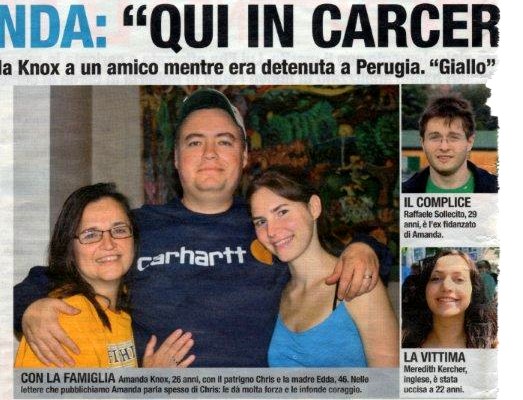
[Header of the Giallo article; the rest off it is at bottom; click for a larger image]
1. The Fake Knox In Her Demonizing Book
Amanda Knox may have felt she was “waiting to be heard” in America but here in Italy we have heard her many times, and we feel we know her pretty well.
Her book and interviews don’t sound like her at all. They sound like nasty legal stunts and nasty PR at work. It is easy to disprove her disparagement of officials and her friends here, and an investigation by the Chief Prosecutor in Bergamo is already under way.
So the big question for us here is not angrily “Who are these appalling police, prosecutor and prison officials, and why did they do these terrible thing?” but sadly “Why was she compelled to invent all this stuff?” and “Why is she so scared to come back?”
2. The Amanda Knox That We In Italy Know
I have translated six of her letters from prison just published in the crime magazine Giallo plus the introduction and the graphologist’s analysis. This is more like the Amanda Knox we know, not the invented one in the book.
1. The Giallo magazine’s Introductory framing of Knox’s letter below
Amanda: “Here In Prison Things Are Okay”
So writes Knox to a friend while she was a prisoner in Perugia. [The true crime magazine] Giallo publishes her letters, and then has them commented on by a graphologist and a psychologist
The letters you see published on these pages are from Amanda Knox, the young American accused, along with her ex boyfriend Raffaele Sollecito, of the murder of the British student Meredith Kercher, that took place in Perugia the 1st of Nov. 2007.
Knox, 26 years old, was acquitted in appeal, but now Cassazione has decided that the appeal must be redone. While waiting for this complicated judicial process to restart, Amanda lives in Seattle, and is traveling around America to launch her new book Waiting to be Heard for which she was paid several million euro by her publisher.
To the American television interviewers, the young American woman has said she is scared of coming back to Italy, because our prisons are terrible places, where she was threatened, molested sexually, and humiliated.
Well, in the letters that Giallo publishes in an exclusive, Amanda writes to a social worker, Maurizio, who helped her, and she seems neither desperate or scared, she has friends and cellmates with which to share many interests, From reading to music, up to manicures. There is a priest, Don Saulo, with which she talks, and confesses, and helps her in her moments of discouragement.
Sure, she suffers from the distance from her family, her loneliness and her imprisonment, but she can see her parents and speak with them frequently, and this notably relieves her suffering.
2. Six letters from Knox to the social worker Maurizio 2008-2010
April 3 2008
Dear Maurizio,
Thank you very much for that letter that for me is very interesting. I was thinking: “Why am I here?”, “why can’t I be with my mother?”, ” Yes the police can think badly about me, and meanwhile I do understand that I have to be in control, not run away from the situation, but why prison? I am 20 years old, never committed a crime, it is senseless. How can they say that I have to stay in prison like the people that can be a danger to others? Above all when they don’t know the truth?
It really is a torture and now I understand the motivation. I understand the motivation, but I do not agree. “Sweet” or not it is a “TORTURE”. I am being tortured and it is not right…...
Sorry. As I said I do suffer a lot in prison. Generally I am scared, alone, with no hope, sad, and tired, even if I am innocent.
Thank you for the article. It is interesting to know how people that do not undergo this torture as I and hundreds others think. To tell you the truth, I can’t understand how some judges can sleep at night, when they very well know that it can be a grave mistake. ah… mamma mia….
Come on! It is O.K. here. I am studying a lot and have started reading Italian Poetry.
Another thing that I like a lot is the song “A te” by Jovanotti. “perché tu sei…semplicemente sei….sostanza dei giorni miei…sostanza dei giorni miei…. (lyric of the song n.d.r.). Have you heard it? According to me it is a live song. It is true. Simple and strong. I like it a lot.
How are you? Do you like the change of weather? I spend more time outside reading a book and singing (I am still alone when I go outside). I am sun tanning but I’m still white white!
Hope you are OK. Love, Amanda
P.S. Let it be! Here comes the sun! I know that I am not alone, even when I am alone
April 28 2008
Dear Maurizo,
Thanks again for your thoughts and your gifts.
I really like the T-shirts and the book of art. Beautiful! Mamma mia the talent of the artists always surprises me! Thanks. But you know, you do not have to buy me anything. I am happy just to hear from you.
Really, [Priest] Don Saulo speaks to me so much about God’s gifts, especially about the strength to overcome the difficult moments, of which there are so many. He bought me a book on philosophy entitled “Umanesimo Integrale” and we speak often of my thoughts and my questions. He is a true friend and a very good man.
It’s true, I must start to read a bit of classic Italian texts. Maybe there are some books in the library for me….......Who can explain to me about “Divina Commedia”? I know it exists and that it is famous, but more than that I am ignorant, unfortunately.
Now my father is here with me, but he has to return to the United States, next week. In his place the husband of my mother, will come. I am happy, because from him I receive a lot of strength. He is like that.
Today I go to the gym course (in a bit) and I have a home telephone call. My first telephone call was last week and I was so excited. The voices of the people I love are really a gift. I trembled a bit after those so little ten minutes.
Now, I must go to the course to sweat a bit. 😊 I hope you are very well. Thanks again for your words.You are very kind.
A hug, Amanda 😊
P.S. Let it be! Here comes the sun! I know I am not alone, even when I’m alone.
November 26 2009
Caro Maurizio,
Ciao, my friend. How are you? It’s from forever that I write you. I imagine that you must have basketball in your head, since it is the season’s sport. I send best wishes to your nephews, who play it. I am terrible at basket. I have very small hands, therefore I can’t control the ball.
I would like to thank you for meeting with my family. Chris told me nice things about your encounter, he was impressed by your generosity. I know that it is always nice and unique, every time that somebody comes toward you and they like you, just like that. Therefore, thank you, for having welcomed him, me and my dear ones.
Nearly, nearly there. O mamma mia, one has to remain strong in these days. I am always hoping so much, even if, in my stomach I feel sick, anxious. More than anything, the closer it gets, the more I have to reinforce my patience against the fatigue and frustration. But I will make it.
A lot of my family will come tomorrow to be in court. There will be my father, my mother, my stepmother and my aunt. My three sisters will be here on Dec. 2. I hope so much to be able to go home with them, finally, this time. I see it in “my third eye” the vision of being on the plane between my mother and my sister. Maybe, I am thinking to much about it.
Anyway, I hope you are well. I must go to sleep early tonight, to be ready for tomorrow.
Thank you for your continued support.
Your friend, Amanda 😊
Here comes the sun! Let it be! I know that I am not alone even when I am alone,
Happy Thanksgiving!
April 20 2010
MAURIZIO
Hi! How are you? I’m happy that I made you happy with the full translation. For me it was a satisfying job, so I thank you too for the chance that you gave me. I don’t think it will be a bad thing put up my name as a translator. OK it is fine for me and yes if you like it, you can even put my second name Marie,
Thank you very much for the towels, to be truthful I really needed them. They are beautiful. I gave one of my pillow cases to the other inmate so we have twin pillows. She thanks you too and sends her best wishes.
Seems like that the weather is finally changing. With great pleasure I was able to wear a skirt in these days. Now people are out and we play volleyball together under the sun. I made friends with a new 19 years old girl: she is an athlete too. Every day we walk or play with the ball together,
Next Friday my mother, father and stepfather will be here for a visit. Mi mother and father are here for a short time to be interviewed on TV at “Quarto Grado” and then will come here. Can’t wait to see them, I miss them with all my heart.
Well, hope that you are fine. Thank you again for everything and salute you with all my affection
Hi your friend, Amanda
I know that I am not alone even when I am alone
August, 30 2010
Dearest Maurizio
Hi dear, how are you? Do you know that yesterday I was taking with D…. about you, only because you are a very special person in this world, for all that you do for others. She told me that you got married. Congratulations! Now I have to tell to my grandmother and break her heart! 😊 Just joking!
I am well enough here. I thank you again for the shorts and shirt that you send me. They were perfect as always. Thanks and I hope that you didn’t lighten your wallet too much. I am kind of disappointed that you spend your money on me, you are too generous. I am always the same here.
Just finished reading a book by Umberto Eco book that I liked a lot. In Italian should be ” L’isola del giorno prima”, I read it in English “The island of the day before”; maybe the “island of yesterday”? Anyway, I was favorably moved by Eco’s organization in this novel in order to communicate so many ideas on science, philosophy, ethic, imagination, literature. It was a book very rich on thoughts, and colpi di scena during it’s path.
I like Umberto Eco because he meticulously builds the story that he wants to tell. Of all he writes, nothing is taken for granted and this is remarkable, he has a fantastic mind to dig deep while following a long track. I saw a Sean Connery movie based on a book of his “Il nome della Rosa?” It was fantastic. Always meticulously built, deep and fascinating.
Seems like that the newspapers know before us when the appeal proceeding will take place. We still have not been officially notified, but my lawyers told me that it should start Nov. 24th; that in the USA is Thanksgiving Day. Hope that it is a good omen even if there is a lot in my life for which I should be grateful: to be alive, having the family that I have etc…
[Undated letter]
Dearest Maurizio,
I am happy to hear from you again. I use now the paper you sent me to answer you. Sorry to make you wait. My mother has returned to the United States nearly a week ago, and my father returns to Italy tomorrow, to see me Tuesday.
I am happy to remain in Perugia. I do not want to restart everything in another place. Also I? (blurred) have heard that the prisons in Rome are harsher than here. Who knows?
I only know that at least I know some of the prison officers fairly well, after all this time. I would be sorry to leave Don Saulo. I feel fine in my new cell. I changed it so I could be with a girl my own age. We joke, cook, we do manicures. Further, she does a manicure for me, because I do not know how to do one. We listen to music a lot because she has a radio.
Thank you for all you do for me. The paper, your words of confidence, your prayers. To Don Saulo I will send your greetings. Do you write often to him too? I hope all is very well with you. I send you a big hug. Ciao! Thank you!
Amanda Knox 😊
Let it be, Let it be! Here comes the sun! (drawing of a sun)
3. Comments by educational psychologist and graphologist Evi Crotti
Looking at the Amanda Knox letters it is evident right away how organized and precise she is: she has a perfect handwriting, elegant and without smudges. We try to interpret it with the help of the graphologist and educational psychologist Evi Crotti.
She explains: Her perfect, organized handwriting, without margins and few spaces indicates that we have before us a girl that is decisive, strong, who wants to dominate, and knows she can succeed in life. She puts herself In the center and leaves no place for others. Amanda displays a way of writing that is typically northamerican, in small print, called script.
The handwriting, elegant, big and curved, reveals an extroverted personality, and with a notable sense of taste. Her language is fluid and polished, and the accuracy with which she writes, tells us that this young girl has a need to maximize and nurse her image, to the point of becoming narcissistic: after her signature she draws herself with a smiling face.
Amanda leaves no space between the lines: this signifies an element of interior loneliness, which she attempts to compensate at any cost with approaches of verbal intrusiveness. This tells us that that her strong narcissistic behavior can escape control and lead her to present unstable behaviors. The fact instead that her handwriting is always in horizontal lines, without blurs, gives testimony to her practical intelligence and her strong tenaciousness, that allow her to reach her goals.
Also, the handwriting is rigid and this signifies that she knows how to use words with care and determination. Evi Crotti underlines that the handwriting is static: It is a sign of a behavior that is very seductive. Attention, the need to be attractive at all costs can make her lose sight of the objectivity of judgment , taking her to a subjective vision of circumstance reality.
Conclusion: Amanda seems to be in a continuous search of approval and acceptance from those who live around her. Her egocentricity, maybe pushed unto the point of a bogus personality, demonstrates that this girl possess a highly emotional immaturity that doesn’t allows her to love in an unselfish way. The handwriting slightly slanted to the left indicates a contradiction between the need to be liked and the reactive refusal toward a feminine figure: for her, probably every woman represents a rival.
Thursday, May 23, 2013
The Very Appropriate Casting Of Doug Preston As The Fredo Corleone Wannabe
Posted by Kermit
Preston as Fredo
In the image above, from the first Godfather movie, Michael’s brother Fredo watches his father Don Corleone get into a Mafioso tussle.
Fredo, after fumbling, juggling, and dropping his revolver without firing a single shot, proves himself useless and incapable of achieving the basic objective of taking care of his kindred souls.
In the same manner, as Douglas Preston fumbles about protecting the interests of his “Family” (and taking care of his own income), he shows the public that the sci-fi writer can’t load his own pen with Truth - or even Believable Lies.
Whenever I see an article published by the sci-fi thriller novelist and pro-Amanda Knox “point-of-view journalist” (his own words) concerning either the murder of Meredith Kercher or the Monster of Florence case, I can’t avoid being reminded of “Fredo” the bumbling brother who lets his family down.
Whoever set Douglas Preston up for his histrionic defense of Amanda Knox, or his attacks against the personal and professional integrity of Deputy Prosecutor General Giuliano Mignini, or his defense of his hapless friend Mario Spezi’s curious “investigative” techniques in uncovering “dirt” on the decades old “Monster of Florence” case should have found a much better soldado than Preston.
Preston’s histrionic pamphlet
Douglas Preston has recently posted an article on The Slate website, promoting a pamphlet that in the end he had to self-publish through Kindle since no one else would publish it (he had told me at the end of last year in an unsolicited email that he was hoping The New Yorker or The Atlantic would print it as an article).
I seriously thought of writing this TJMK post as a self-published Kindle article that could be downloaded for 99 cents, but I refrained from doing so for two reasons:
- 1) I wanted it to get more exposure than Preston’s nickel-and-diming effort has
2) I will never want to earn any blood money off the backs of crime victims, even if it’s only the grand total of 99 cents from the Kindle copy my mother buys
Preston’s The Slate article and Pamphlet are basically an attempt to undermine the PMF and TJMK websites which have taken a pro-victim posture in the online discussion concerning the murder of Meredith Kercher in Perugia, Italy, in November 2007.
As such he stumbles and fumbles with the Truth in promoting his “Family” causes, with as much dexterity and morality as the low-grade Mafioso “Fredo” from The Godfather, unable to load his writer’s gun properly, in a comic show of futility.
Preston’s Weird “Truths” and Fumbling Propaganda ““ Technique #1: Tell Favorable, Out-of-Date news from the Past
Novelist Preston starts telling his unconvincing twisted half-truths before he even finishes the title and subtitle of The Slate promotional article:
Burn Her at the Stake - Amanda Knox was acquitted of murder. Why do so many people still hate her so much? (Source: The Slate)
That title has as much truth as Preston writing another self-promotional article today announcing to the world “I turned 21 years old” “¦ it may be true that years ago in the past he was 21 years old, but that is hardly a current truth for readers.
While it may be the case that accused murderer Amanda Knox was acquitted of that charge in 2011, it is now an old truth, after the Supreme Court of Italy in March chastised the appeals verdict of Judge Hellman (now forcibly retired from the judiciary) and annulled that acquittal, putting her status back to the conclusion of her initial murder trial.
(Later in the article Preston makes a brief mention that she will be retried, barely associated with the headline message he sends to the world in the title to his article. Knox’s current situation is the polar opposite of being acquitted; rather, she is still fully charged with murdering Meredith.)
Preston, the public wants you to start broadcasting the truth, the current, real truth, in messages that are for once free of highly misleading insinuations.
Preston’s Weird “Truths” and Fumbling Propaganda ““ Technique #2: Use Weak Statistics To Support Insinuations
Preston does a number of Google searches and becomes shocked, shocked that he gets hundreds of thousands of hits with combinations like “Amanda Knox” and “pervert”, or “Amanda Knox” and “slut”.
Preston knows full well, as do the readers of The Slate (and the handful of persons who have read the long version of The Slate article, paying 99 cents for the 10 minute read), that you always get hundreds of thousands or millions of Google hits for just about any Google search, however shocking the search terms may be.
Preston says “The extreme viciousness of the anti-Amanda commentariage is startling”.
Let’s do a fast test, and do the same Google searches that Preston did, replacing “Amanda Knox” with “Hillary Clinton”. Here are the results:

Here are two public figures: Knox on the left has been in the news for 6 years “¦ she would probably be a forgotten figure, just another semi-anonymous American abroad with problems if it hadn’t been thanks to the expensive corporate PR campaign that her own family has waged. That PR campaign has propelled the number of overall appearances of her name, and has pushed Internet commenters of all types to opine on her.
Hillary Clinton on the right has been in the news for 3 decades or so, as reflected in the proportionally higher number of Google hits on her name. In spite of not being accused of sexual assault and murder, she still receives a relatively high number of sexual/sexist descriptors.
Knox is not in the news because she has worked on public health reform, or because she has been a Secretary of State, or because she lived in the White House with her husband. Knox is accused of sexual assault and murder. She is also a convicted felon, having served 3 years in an Italian prison (no further appeals) for falsely accusing her boss of murdering Meredith, in Knox’s presence.
Knox outdoes Hillary in percentage of hits for “bitch” and “slut”, but Hillary betters her for “pervert”. Who cares? In Internet, any public person can get Google hits for just about any descriptor, especially if you are accused of a sexual crime.
Let’s extend our test a moment, and do an additional Google search: “Douglas Preston” “slut” “““Knox” . By eliminating references to “Knox” we eliminate any testing contamination from Amanda’s Perugia murder charges and the ensuing online discussion and reporting. Preston shouldn’t be surprised to learn that compared to Amanda Knox’s 380,000 “slut” hits, Preston has 73,400 of his own “slut” hits. Not bad. Of course, all of these results require analysis, which is exactly what Preston doesn’t provide in his pamphlet.
Here’s one of Preston’s “slut” Google returns, his own sci-fi novel texts:
“The town slut. She was in this cell just last month, wasn’t she, on a drunk and disorderly. Like mother, like daughter. Guess the apple never falls far from the tree. Or in your case, the shit never falls far from the asshole “¦ the murderer might be local. Maybe a devil worshiper. You fit the bill, with that fucked-up purple hair and black eye makeup. Is that what you do at night? Go out and do mumbo-jumbo? “¦ Bitch,’ Brad muttered “¦ ‘no man would ever want to screw you, you freak.’” “¦ (Poor tormented Preston; that’s from his book Still Life with Crows that he curiously dedicated to Mario Spezi.)
Preston’s Weird “Truths” and Fumbling Propaganda ““ Technique #3: Tell Contrasting Stories About Personal Suffering at the Hands of An Abusive Prosecutor
In an interview in The Atlantic in 2006, well before Meredith’s murder, Douglas Preston was asked about Prosecutor Giuliano Mignini:
Question: “Judge Giuliano Mignini, the public prosecutor who interrogated you, is another important player in the case. Was Mignini just doing his job? How much weight do you give to the idea that Mignini had it in for Spezi and you?”
Preston: “”¦. As for Mignini himself, I think he’s a sincere man and an honest and incorruptible judge. I don’t think that he’s a bad man “¦. I think he was doing his job the best he could. I think in many ways he was badly misled by Giuttari, the police officer who was running the investigation.”
At that point in time, the Bad Guy for Spezi and Preston had been and still was Police super-inspector Michele Giuttari. But that didn’t seem to sell. They needed something to spice up their tales about the Monster of Florence, which weren’t achieving whatever objective they may have set themselves. The breakthrough for Preston and Spezi came with Meredith’s murder. Preston today with his Pamphlet admits to being recruited early on by the pro-Amanda Knox movement just after Meredith’s murder:
“A few days after Amanda Knox was arrested for murder, I got a call from a man named Tom Wright “¦ a well-known filmmaker “¦ (who) knew her family “¦ (he) begged (Spezi and me) for help “¦. I felt like I had to become involved.” (Source: Preston’s Pamphlet on Kindle)
[Image above: Thomas Wright’s “famous” screenplay skills seem to rival only Preston’s writing skills that we’ve seen.]
Preston has never admitted this early recruitment contact before. In his Afterword to the English-language version of their tale The Monster of Florence, Preston writes about a different call that he got just after Meredith’s murder:
“A few days after the crime, I got a call from Niccolò Capponi “¦ ‘My dear Douglas “¦ I bet you a bottle of ‘97 Chianti Classico that before the week is out someone will connect this poor girl’s murder with Monster of Florence’”.
Capponi, whose relation with Spezi and Preston deserves its own tome, couldn’t have been more astute. The Friends of Amanda movement didn’t need anyone other than Douglas Preston to crow out to the world that Mignini wasn’t actually a benign, “sincere”, “honest” and “incorruptible judge” (Preston’s own prior words up until then). Instead, Preston rewrote his own storyboard and retroactively turned the Mignini of early 2006 into one really nasty guy:
“The police then picked me up on the streets of Florence and hauled me in before Mignini, where he interrogated me for hours, with no attorney or interpreter present. He demanded I confess to a string of crimes, including being an accessory to murder, and when I refused, he indicted me for perjury and obstruction of justice and suggested I leave the country.” (Source: Preston’s Pamphlet, on Kindle)
Preston has changed his tune about how his Perugian questioning in 2006 was arranged. In his earlier book from five years ago he described a different ambience that pleasant day on his way to Perugia, with a notable absence of jackboots “hauling him in”, originally stating that it was actually a family-outing:
“¦. “The next day I drove to Perugia with Christine and our two children, passing the shores of Lake Trasimeno on the way. Perugia, a beautiful and ancient city, occupies an irregular rocky hill in the upper Tiber valley ... Christine planned to sightsee with the kids and have lunch while I was interrogated”. (Source: Preston and Spezi, The Monster of Florence)
Driving down to Perugia with your wife and family contrasts with being “hauled in” after being picked up in the streets of Florence, yet Preston, it seems, adapts the truth and insinuations to the required needs and circumstances.
By the way, Mr. Preston, what murder did Prosecutor Mignini accuse you of being an accessory to? You keep repeating it, and we’re still waiting to hear. What murder?
Preston’s Weird “Truths” and Fumbling Propaganda ““ Technique #4: Use illogical deduction and dodgy Internet sources for your facts
Preston makes some amazing logic relationships in his pseudo-scholarly study of pro-victim Internet voices. When describing a book that the pro-Knox forces seem to find against their interests, Preston says:
“While the book included no footnotes or bibliography, it appears to have used information sourced from anonymous bloggers “” identifiable as such because it was incorrect.” (Source: Preston’s 99 cent pamphlet)
I don’t think that the reasonable public out there requires any analysis of this fatally flawed “if-then” logic. Preston-Fredo needs to go back to school, either to grade school to do basic maths, or to the Daisy Hill School of Influencing People and Spreading Convincing Propaganda.
This is an important lesson for Preston, who often relies on the daisy-chaining, circular, internal feeding of “facts” amongst pro-Knox promoters. Preston himself, like a post-modern journalistic alchemist, turns wishful opinion into “fact”, using as raw material the opinion posts of “Friends of Amanda” anonymous bloggers who use various identities.
Let’s take a look at three of the most active and factually flawed pro-Knox bloggers who people like Preston have helped turn into Knox-Urban-Legends, dragging along their pro-Knox fictions.
The photo below comes from a FOA-Fest last summer on Vashon Island where Amanda could thank all her limited number of close supporters for their help in springing her from prison. On the left is Bruce Fisher, or Bruce Fischer (depending on the day). One of his most hilarious affirmations which he vehemently defended until it was impossible to continue to do so, was that a box of Dixan detergent that he spotted in a photo of Sollecito’s sink would explain why Sollecito’s cutlery may have smelled of bleach “¦ except that Dixan is clothes washing detergent!
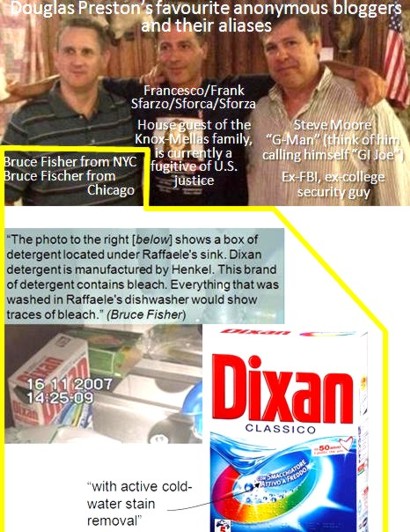
The hilariousness of Fisher/Fischer’s Internet postings can also take on sinister results when passed on to the hands of either an inexperienced or ethically challenged journalist or a “point-of-view” journalist. Preston refers to a post by Fischer as if it were fact when he publishes in his 99 cent Kindle pamphlet that a prominent pro-victim blogger “had a restraining order placed against him” for a non-existent harassment of a ballet dancer.
Why doesn’t Preston also say that the web-site where this post was placed by Fisher/Fischer quickly removed it when it received the corresponding complaint? Why didn’t Preston ask Fisher for any proof of the “restraining order”? Why didn’t he cross check his facts/falsehoods?
Why should a best-selling sci-fi novelist stoop so low? Money? Anger? Envy?
Another of Preston’s anonymous or multi-alias bloggers whom he has quoted or protected is Francesco (“Frank”) Sfarzo / Sforca / Sforza. Take your pick of the last name as he has used them all in public documents.
“Frank’s” supposed beating at the hands of a squad of goon cops beholden to Prosecutor Giuliano Mignini was curiously covered by the Committee to Protect Journalists in prominent website posts and a public letter to the President of Italy, with no effort whatsoever to investigate the claims or speak with the local Italian authorities.
CPJ’s reputation remains tarnished as they refuse to this day to recognize their massive screw up. Shame on Joel Simon, director of the CPJ! Is there no governance in that organization?
Should a financial contributor to CPJ such as Preston also be permitted to be a figure in the anti-Italian judicial lobbying that CPJ has consciously or unconsciously ended up participating in?
Preston’s role in this laughable attempt to frame Mignini is only made all the more tragic by the fact that “Frank’s” arrest in Italy (which Mignini had nothing to do with) was related to a complaint of domestic violence.
He left Italy, and ““ staying at Amanda’s family home in Seattle for a couple of months, then travelling to Canada, Hawaii, then back to a shared residence in Seattle - racked up an impressive set of arrests and police interviews related to further domestic violence complaints during his travels.
He currently has an arrest warrant issued, and Preston has suddenly stopped talking about his and Spezi’s prized asset who was supposed to be the living demonstration of the Bad Mignini.
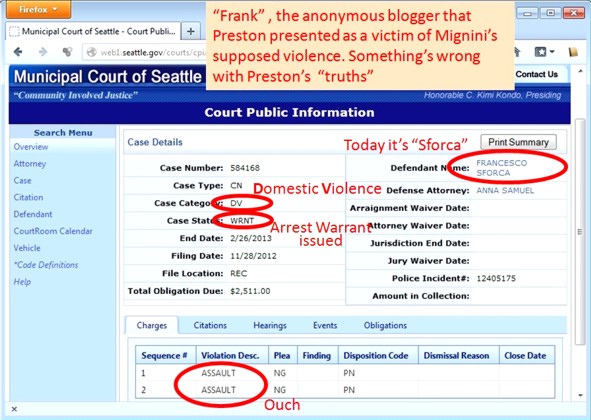
[Image above: Preston’s pet blogger “Frank” is not at all a victim of violence, but rather to the contrary, has an arrest warrant out to face charges for instigating it]
Amongst “Frank’s” contribution to the “point-of-view” journalism supporting Amanda Knox has been his visit to Piazza Grimana, the square near the cottage crime-scene, where “Frank” took a photo that supposedly demonstrated that Knox and Sollecito could not have monitored the entrance to the cottage from there on the night of the crime, since you can’t see the cottage gate according to “Frank”.
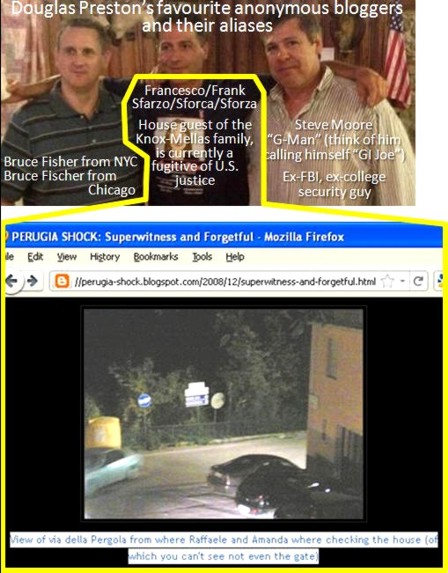
Any person who goes to Piazza Grimana in Perugia knows perfectly well that if you step just a couple of metres to the left, you have a perfect view of the cottage gate, barely hidden in “Frank’s” photo behind the corner of the house on the right.
Yet another case of the danger of Preston using pro-Knox bloggers and friends as sources of unreliable information is that of the G-Man, ex-FBI agent and ex-college security guy, Steve Moore.
In the sake of honesty, of the three pro-Knox bloggers referred to in this post (we could go on forever about the menagerie of Knox Internet personalities), Moore is the least anonymous, although it should be said that his “G-Man” aura he promotes is perhaps self-deprecating humour (think of an adult guy using a nickname like “GI Joe”).
G-Man has developed an elaborate tale of how he became interested in the case and began to study detailed documentation and images to come to the forensic conclusion in his living room that the Italian investigation into Meredith Kercher’s murder was flawed and that Amanda Knox was innocent. (Moore’s experience before he left the FBI as far as I’m aware is escorting suspects to court, sniper training, and flying helicopters “¦ I don’t believe he has worked as a forensic specialist.)
Like in the case of Bruce Fisher/Fischer, there are semi-comical aspects to G-Man’s appearances on the Internet supporting Amanda Knox. This happens when you get someone who is not a forensics specialist looking at photos and making conclusions:
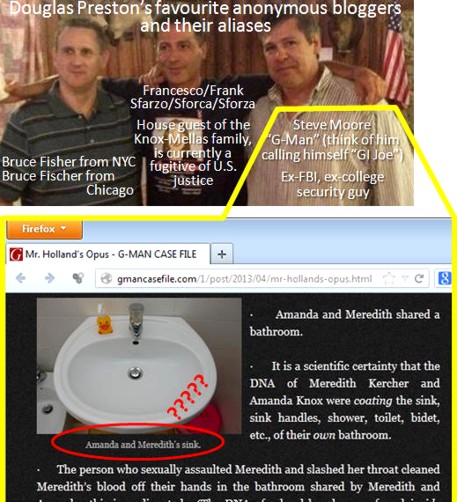
Unfortunately, Steve Moore was analyzing an image that was not “Amanda and Meredith’s sink”! This example of errors in G-Man’s contributions to FOA finding Amanda innocent is far from being the only one.
In Preston’s Pamphlet, he presents the anecdote of a pro-victim Internet commenter who made what Preston claims is a “threatening” comment concerning the quality of G-Man Steve Moore’s daughter’s song lyrics. In the light of honesty and telling all the truth, Preston should have stated that after Mom and Dad Moore, the next most prolific pro-Knox poster of the Moore family is their daughter, who has made posts on both pro-Knox and pro-victim sites, on Twitter and on Facebook, including posts with coarse language.
She seems to be an adult, but if she isn’t, then Mom and Dad Moore should start acting like better parents, being aware of their offspring’s internet activity, putting a filter on their home router and telling her to not make posts on sites that deal with a sexual assault and murder case. Nor should they allow their daughter to leave her own pages open for comments and or to post videos about the murder. And if their daughter is an adult, then Preston shouldn’t insinuate to his few readers otherwise.
By the way, the “threatening” post was a return of a phrase used by a pro-Knox poster that “Steve Moore plays for keeps” after a playful criticism of the quality of lyrics written by Miss Moore.
This is a lesson to Douglas Preston: any journalist, even that special lobbyist category of “point-of-view journalist” such as himself, is only as credible as his sources.
Preston’s Weird “Truths” and Fumbling Propaganda ““ Technique #5: Claim That You Have Already Made Any Needed Explanations
Preston says in his Slate article: “Like a fool I waded into the (Internet) fray, defending Amanda and myself. I attacked my attackers and countered their criticisms.”
(Why does Preston have to “defend” Amanda? I thought he was now presenting himself as a journalist. Oh, I forgot, he wrote that he now considers himself a “point-of-view journalist” ““ his terminology - which sounds a lot like “lobbyist”.)
Actually, Preston has never countered any serious criticism. I ask readers to take a fast look at the Committee to Protect Journalists’ comment page concerning the CPJ’s fiasco accusing Prosecutor Mignini of directing a vicious, violent attack on “Frank” the blogger by a squad of rogue police beholden to the prosecutor.
Preston went wacko when he saw the Internet world laughing out loud at the CPJ’s allegations, and when he saw that the Internet provided different proofs to show that the now fugitive blogger was at best making up his story, or had other persons close to the action making it up for him.
Take a look at Preston’s emotional replies to CPJ readers’ comments.
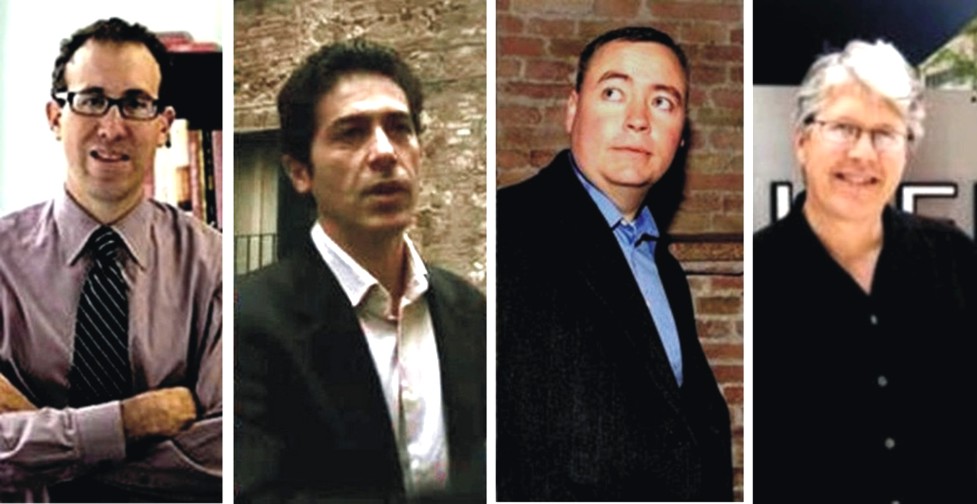
[Image above: on the left we see CPJ’s director Joel Simon, who accused Prosecutor Giuliano Mignini of sending a police squad to beat up “Frank” the blogger (second from left). “Frank” is a family friend of the Knox-Mellas families, taking care of much of their logistics in Perugia, setting up photo shoots, etc. “Frank” stayed at the Mellas home (Chris Mellas, second from right) for a couple of months during his arrest-ridden trip out of Italy, when his domestic violence trial started up there. On the right, Preston, the glue that links “Frank” to the CPJ.]
On the web pages of CPJ, we see that not only does Preston not reply to the contradictions and lies that the Internet world points out in his words and actions, but he also puts conditions on doing so.
The best “countering” of criticism that Preston provides online is pretty pathetic. He says that the demonstrated errors in his and the CPJ’s texts “are distortions, falsehoods, and crackpot opinion presented as settled fact.” Period. No explanations of why he says one thing in one place and something completely different in another. No transparency concerning his documented relationship with the CPJ. No honesty concerning the real, sad domestic violence case that “Frank” has had before him, brought on by his own family in Italy (in addition to his U.S.A. problems).
We’re still waiting for any real clarifications of Preston’s serious problems with the truth, the whole truth, the current truth and nothing but the truth.
I personally don’t need to see more verbiage from Preston, but I would have thought that he would be concerned about the public’s view of his credibility. It will probably help future “True Story” book sales if he were to clear up the confusion he causes about both the Monster of Florence case and aspects of the investigation and trials related to the murder of Meredith Kercher.
Preston’s Weird “Truths” and Fumbling Propaganda ““ Technique #6: Write Any Incorrect Gibberish That Doesn’t Get Error-Checked If You Think that Unknowledgeable People Will Swallow Your Errors
Preston once crowed concerning the quality of his texts:
Before publication, it was minutely vetted by no less than five attorneys in two languages in Italy, the U.K., and the United States. Since publication, it has been read by millions of people in many European languages. In all that time, and with all the millions who have read the book, not one significant error of fact came to light. Mario Spezi and I stand by every single assertion of fact in that book today just as strongly as we did when it was first published three years ago.” (Source: Preston on CPJ)
I once suggested to Preston that he ask his five error-checking lawyers for his money back, after the multiple mistakes and falsehoods of The Monster of Florence came to light and it became apparent that it should be reclassified to “Fiction”.
It seems that both Raffaele Sollecito and Amanda Knox used the same error-checking lawyers in their memoirs, and that once again Preston and Spezi have employed them for their underwhelming, unknown tome in German Der Engel Mit Den Eisaugen (The Angel With Icy Eyes). No other market seems to have wanted to hear more from the Dynamic Duo of murder “point-of-view journalism”. As you can expect, their book about the murder of Meredith Kercher is not about the victim, but about the star, from their point of view, Amanda Knox.
I believe that never in the history of “True Story” lobbying, has a book taken so little time to rack up so many factual errors.
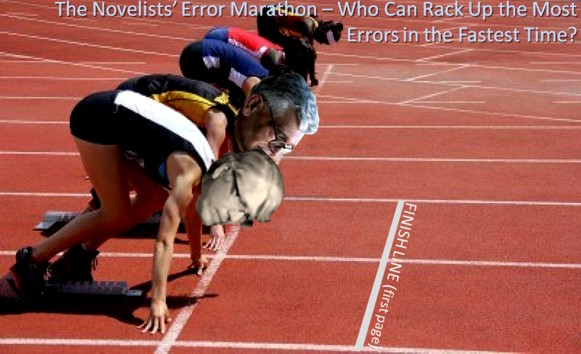
[Image above: Preston and Spezi are sure bets for winning The Novelists’ Error Marathon, especially given the finish line they’ve set for themselves. (By the way, I will state the obvious here, that this satirical image is the only photo that has been “photoshopped” in this TJMK post)]
In the Forward to their limited market book, Preston kicks off the marathon, asserting first of all that Perugia is surrounded by “¦ the hills of Tuscany (“In der schoenen alten Stadt Perugia, umgeben von del Huegeln der Toskana”). Where’s a smiley when you need one? To all readers of this post, I ask you that we keep the secret, and let Preston and Spezi figure out by themselves what’s wrong with their statement. I guess the Duo were in a hurry to get the book to market.
Slightly further down the same first page, Preston falsely asserts that the Prosecutor Office (“Staatanwaltschaft”), understood to be Mignini, called a triumphant press conference where “case closed” was victoriously declared to the microphones of the Press.
Of course, neither Mignini nor any other prosecutor held such a press conference, nor was he present at any other press conferences at that time. My only explanation for this error by Preston is that he is so obsessed to assign just any supposed bad behavior to Mignini that he sees visions of the prosecutor doing wrong and turns those visions into “True Story” words.
The problem with that explanation of “visions” is that it is how Amanda Knox justified her false accusation against Patrick Lumumba for murdering Meredith, and that false accusation got her three years in the Capanne Prison Spa.
Just another 4 lines below that, Preston claims that within those immediate days after the arrests, Prosecutor Mignini put forward a scenario of Satanic sexual rites for describing the human dynamics on the night of the crime (“das eine amerikanische Studentin namens Amanda Knox mit zwei anderen Personen in den Mord verwickelt sei, den die Staatsanwalt als eine Art sexuelles-satanisches Ritual unter Drogeneinfluss bezeichnete”).
Again, Preston got confused. Or, maybe he wrote exactly what he was wanting to write, even if it was wrong.
Let’s not leave Mario Spezi out of the Novelists’ Error Marathon. Spezi tries to keep up with Preston in the home stretch, in Chapter 1: when emphasizing how isolated he feels that Perugia is from the outside world, he describes Umbria as “the only Italian region that does not border with the sea”. Spezi must have had a football scholarship at school, because it seems that he forgot about Lombardia, Piemonte, Val d’Aosta and Trentino & South Tirol. These regions account for about a quarter of Italy’s population and include large cities such as Milan and Turin.
We’ve barely started looking at their Icy Eyes book, but we’ll leave a more exhaustive review for the future.
Maybe Preston and Spezi hope that the few German readers of the book (who may have received their copies as free review copies) won’t know or care. It’s possible that they won’t even finish the book.
Preston’s Weird “Truths” and Fumbling Propaganda ““ Technique #7: Apply Your Own Words to Others in Order to Distract from the Central Issue
Preston claims in The Slate article about pro-victim Internet posters: “Almost all the nasty comments about (Knox) follow a pattern. Even though she did nothing to them, they are all demanding her punishment.”
Personally, I don’t “demand Knox’s punishment”. Preston and the rest of FOA know that by now. What the pro-victim Internet posters want is for the Italian Justice system to be left to do its job, without any outside interference by a corporate, multimillion dollar public relations campaign, or ““ if we get to the point where Italy asks for Knox’s extradition ““ non-juridical or non-treaty political interventions to interrupt this normal administrative procedure.
Of course, those persons who are found guilty of sexually attacking and murdering Meredith should get the punishment that the Italian legal system foresees in such cases.
The pro-Knox camp has been outraged that Rudy Guede may be released from prison as early as 2014, insinuating that he has struck a deal to frame Knox. Any honest and informed opiner on this case would know that Rudy has only followed the well established legal and penitentiary procedures in Italy that apply to all convicts, and had Knox followed the fasttrack trial as he did, she also could have been looking at early freedom.
If the pro-Knox camp is so outraged that Guede may get free in 2014, I would suggest that they lobby that sentence reduction procedures be changed so that murder convicts serve their whole prison sentence. Somehow, I don’t think that the pro-Knox camp will undertake such lobbying.
Preston’s Weird “Truths” and Fumbling Propaganda ““ Technique #8: Don’t be transparent or precise
Preston describes in his Pamphlet how in 2000 he moved to Italy with his family and soon after became fascinated with the Monster of Florence serial killings case and teamed up with journalist Mario Spezi to investigate the case and write a book.
“Giuliano Mignini did not like our investigation”, he states as the start of a series of supposed abuses they suffered at the hands of the prosecutor.
Maybe Preston should state that after moving to Italy in 2000, he didn’t meet Spezi until 2001, and up until 2004, over the course of three years, it seems he drank a lot of coffee with Spezi, drove to a couple of the decades old Monster crime sites in the country roads around Florence, spoke to the mother of one of the victims, kept a scrap book of what the real, active reporters on the case were doing “¦ and not much more.
Only after almost four years following his arrival in Italy, does it seem that Preston’s active “investigation” suddenly started and kicked into high gear in January of 2004 when Spezi’s friend Francesco Calamandrei, the pharmacist of San Casciano, was drawn into the Monster of Florence investigation. Spezi woke up on the Monster case, did an interview with Calamandrei, and got it published in La Nazione within 24 hours on 23 January 2013. Without mentioning that he was a friend of Calamandrei.
It should be noted that the prosecutor who ordered this “wake-up call” for Spezi wasn’t Prosecutor Mignini from Perugia, but rather Prosecutor Paolo Canessa from Florence, the central prosecutor for the Monster of Florence case.
Preston’s rewriting of history and intertwining fiction and half-truths related to the Monster of Florence case and fiction and half-truths related to Meredith Kercher’s murder in Perugia has brought him time and time again to present Mignini as the key figure in the Monster of Florence case:
Mignini theorised that this satanic cult consisted of powerful people ““ noblemen, pharmacists, journalists and freemasons ““ who ordered the Monster killings because they needed female body parts to use as the blasphemous wafer in their black masses. Putting himself in charge of the investigation, Mignini became so obsessed that he crossed the line of legality, wiretapping journalists and conducting illegal investigations of newspapers. (Source: The Guardian)
(It should be said that Preston really should clean up his old message, and tell readers that any and all abuse of office accusations against Mignini were thrown out: he has neither been found, nor now even been accused of any wrongdoing in relation to the Monster of Florence case - quite the opposite, the rogue Florentine prosecutor who initiated the cancelled proceedings against Mignini may have some questions to answer).
Again, Preston’s own words belie his transformation of Prosecutor Mignini. Remember that before Meredith’s murder, Preston’s Bad Guy with satanic theories wasn’t Mignini, but Police Inspector Michele Giuttari.
You can imagine that had Mignini not been the prosecutor of Meredith’s murder case, but Giuttari had been involved in the police investigation into Meredith’s murder, that Preston and Spezi could have saved their whole effort in demonizing Mignini, because they were already halfway there with Giuttari.
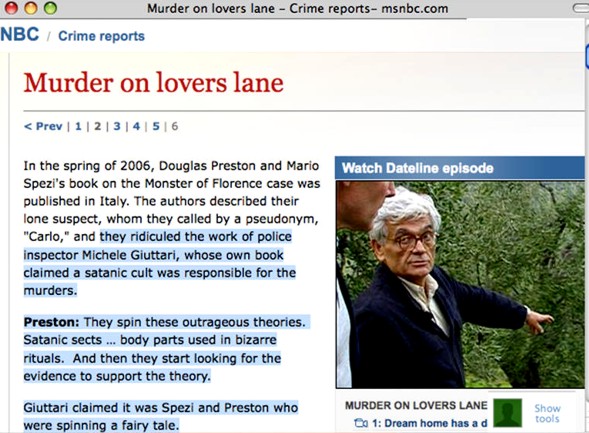
Why did Spezi and Preston suddenly get on the case and start sculpting their Monster of Florence tale in early 2004 following Calamandrei getting caught up in the police investigation? I would love to know.
Why did they apply a pre-existing Monster of Florence theory developed by English fiction writer Magdalen Nabb many years before?
Nabb was referred to as “Ethel”, a Belgian writer, in the Italian version of Spezi and Preston’s tale, while Nabb was still alive. Preston simply eliminated Nabb completely by the time they translated and published the tale in English, after Nabb’s death. In an eerie and weird manner, some of the years-old Nabb-Spezi, Master-Apprentice conversations in the Italian version of MoF seem to be transformed into current Spezi-Preston Master-Apprentice conversations in the English version of their “True Story” tale, almost as if they took on her personality.
I guess they weren’t too worried about presenting as their own, current “investigation”, ideas and theories (correct or not) that had been floating around for a decade and developed by other ““ now unacknowledged - much better writers.
[Image above: In Preston’s and Spezi’s English language book The Monster of Perugia they morphed English author Magdalen Nabb’s Carabinieri contacts, as well as Nabb’s theories and conversations concerning the MoF into their own, with neither direct nor indirect recognition of Nabb’s existence, nor her work done nearly 10 years earlier. Maybe they felt that since she had passed away, the world wouldn’t notice their intellectual theft.]
Preston’s Weird “Truths” and Fumbling Propaganda ““ Technique #9: Use corporate media as a means to legitimize false claims
The CPJ’s false and unverified accusation against Mignini for supposedly sending a goon squad to beat up the Perugian blogger is exactly the sort of feed that the Friends of Amanda and the Gogerty&Marriott corporate PR campaigns needed. These groups repeated the invented injustice wherever they could within the ongoing campaign.
That’s where we find a link between the PR campaign and the “mainstream” American media and showmen. If you Google “Doug Longhini” and go to the CBS News site associated with him, you’re not quite sure at first glance if he’s an ethical traditional journalist, a “point-of-view” journalist, a CBS producer, or an external businessman. What is clear is that it seems that most of whatever it is that he does at CBS is dedicated to Amanda Knox and, in second place, in general the crime in Perugia.
However, when you start reading some of his articles or news reports, like the one below, you realize that he’s not a traditional journalist who checks his facts and tries to get all angles on a news story.
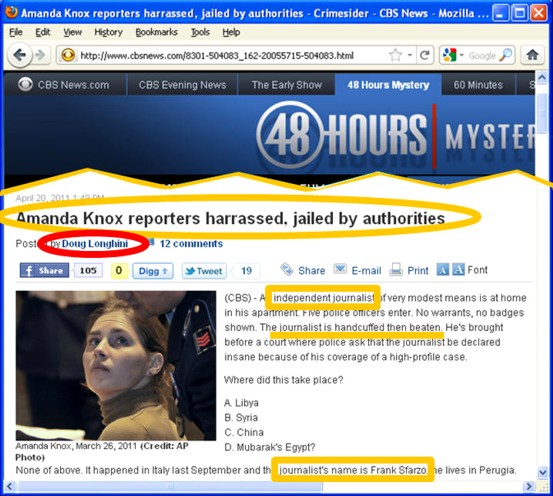
I used to be impressed with the effort that went into the 48 Hours type of investigative programs. Not any more. Describing “Frank” Sforca/Sforza/Sfarzo as an “independent journalist” when this pro-Knox blogger acted as the logistics manager for the Knox-Mellas clan in Perugia, including organizing photo shoots for the daughters, stayed with the Knox-Mellas family a couple of months in Seattle, and was the beneficiary of ongoing funding from pro-Knox circles even after he was a no-show for his latest court session last December in Seattle, is stretching the definition of “independent”.
This Longhini article almost reads as if Douglas Preston had written it “¦ I would have hoped that Longhini might have made some reference to his sources for his description of “Frank” being handcuffed and beaten, or that Longhini would have looked into the true reports of “Frank” being arrested, not on orders of Mignini, but simply because he bit a police officer who was responding to a domestic violence complaint.
Doug Preston is no stranger to Longhini’s CBS 48 Hours pro-Knox shows, having appeared together with another shared acquaintance, a certain Paul Ciolino. Paul’s role in the Knox CBS shows was supposed to be the implacable investigator who knows the truth that the Italian authorities want to hide.
However, Ciolino’s on-screen antics for many viewers are in detriment to the argument he tries to make.
For example, what serious television detective in the world, not speaking the local language, would go calling at the door of unsuspecting murder witnesses at nighttime, vehemently exhorting them to reply to questions? Paul did:
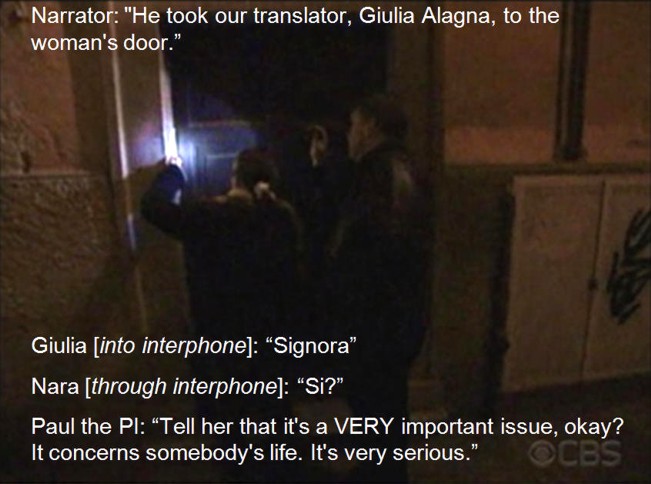
Where does this leave the state of modern megamedia journalism in America? It has been transformed into entertainment, into a vaudeville show. The confirmation comes in Paul Ciolino’s own self-advertising:
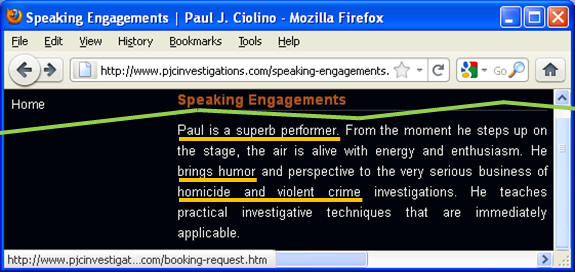
The only thing missing is Liza Minnelli singing “Cabaret” in her black stockings.
Back in America, Preston’s friend Ciolino smears the good name of Signora Nara Capezzali, the elderly lady who he tried to interview under the cloak of darkness (if he really needed to interview her, couldn’t he have arranged to meet her through prior arrangement, during the daytime?):
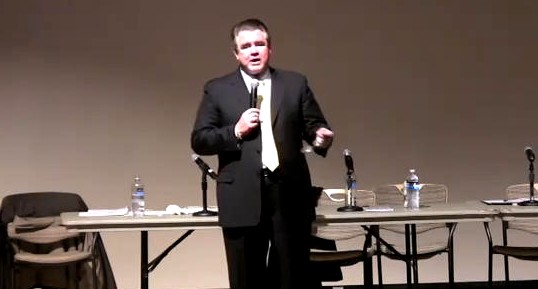
After describing Prosecutor Mignini as a “convicted felon”, Paul Ciolino speaks of Signora Capezzali at the 1h42’47” mark of a Seattle University pro-Knox forum on 4 April 2011: “The crazy woman (Capezzali) who had ... I don’t think she ... did she ever testify? They never did bring her in because she is crazy.” (Source: Seattle University FOA panel video.) Ciolino’s speech was notable if only for the almost complete absence of any truths.
In fact, yes, Signora Capezzali did testify in court in Knox’s and Sollecito’s murder trial, two years earlier in March 2009 (Source ABC News ). It’s not necessary to add that in spite of Ciolino’s vaudeville show affirmations, witness Signora Capezzali is not crazy.
My Concluding Suggestions
1. To Joel Simon, the director of the Committee to Protect Journalists:
Rather than doing false posts that are never retracted or corrected about benign regional Italian prosecutors in Italy, the CPJ should realize that there is a much, much greater, real and true threat to journalists and journalism due to the transformation of the profession in America into a concentration of commercial enterprises with links to lobbying groups, who use vaudeville-style “entertainers” to wake up murder witnesses in the dark of night and then publicly call them “crazy”.
Mr. Simon, really, it’s time for you to implement some governance in your organization. Here are some common sense suggestions that I humbly submit:
- 1) Don’t allow your financial benefactors to be part of the cases that you take special interest in, except with independent review of your analysis and claims.
2) If you’re a journalism organization, follow basic journalistic ethics by checking your facts and contrasting allegations, especially when you are making claims that seriously affect the reputations of persons.
3) When you realize that you have made a terrible mistake and have falsely accused someone of sending a goon squad to beat up someone else, then be man enough to admit it and correct your false accusation. Start now and apologise to Prosecutor Mignini for the slanderous gift you made to Amanda Knox PR campaign.
4) Take some time as a collective representative organization, to consider and reconsider whom you represent and why “¦ are self-described “point-of-view journalists” (lobbyists) part of the body of professionals you wish to represent? Will they cause you a conflict of professional or moral interest at any point? Do you want these people giving money to your organization?
2. To Douglas Preston, an amateur crime fighter obviously out of his league.
My impression from what we’ve seen is that your attempts at playing in the big lobbying leagues have all ended up with pie in your face, or a “kick-me, I’m stupid” yellow Post-It on your back:
- 1) As we have seen in this post, ethical, traditional journalism gives way in your recent The Slate post and Kindle 99 cent pamphlet, to obvious and ineffective pro-Knox lobbying. In my opinion, the propagandistic shots you’ve fired have neither been convincing nor contain real, true facts unfettered from insinuation and half-truths and falsehoods.I
2) In prior TJMK posts, we’ve seen how you have told two completely different beginnings to your Monster of Florence tale, complete with quoting different persons at different times in different places. You have ended the story with a confusion of errors and falsehoods. See my posts on this here and here.
3) It seems you’re famous in Italian judiciary circles for having lost control of your sphincter in your questioning in Perugia years ago. Is that one of the reasons you’re so mad at Prosecutor Mignini and say just about anything about him, regardless if the message to your readers is true?
4) Like Fredo, you were always the last member of the gang to find out what was going on. Your supposed “5 year” investigation with Spezi into the Monster of Florence seems more like a rehash of old theories developed by others, done in a short period of time by Spezi only from 2004 onward (notwithstanding your scrapbook of other reporters’ work), who would inform you at the last minute of his larvae studies, his TV appearances, or of his “A-Team” investigative squad comprising an ex-con and an ex-cop, who you realized existed only when their months of work had finished.
Fumbling Fredo’s handlers in The Godfather realized the terrible damage he was doing to the Corleone Family’s interests. Is Preston damaging the true, long-term interests of Amanda Knox?
What about his other interests, in the Monster of Florence case “¦ is he truly aware of all of the interests in that case, beyond his own ““ repeatedly voiced ““ hope of seeing George Clooney play Preston?
Wednesday, May 22, 2013
Seeds Of Betrayal: Sollecito Twice More Implies Evidence Against Knox Much Stronger Than Against Him
Posted by Peter Quennell
Above and below are two videos of TV interviews in the past few days which will give real weapons to the prosecution coming up.
Nobody who is innocent ever needs to lie to contradict a huge amount of evidence to the contrary. At the 2009 trial and the 2011 annulled appeal, Sollecito was kept carefully circumscribed by his own lawyers.
Giulia Bongiorno was often observed firmly making him toe a line. If she liked him, it sure never showed, and she had little response when some fairly disgusting things about him came out.
Sollceito’s spontaneous interventions in court made him look whiny and guilty and never did him any good, and unlike Knox he was never game to be cross-examined by the prosecution on the stand.
But since his release, in his interviews and especially in his self-serving book, he has done his level best to convince the world “I saved Knox!!”.
In both videos, he is repeating the same false claim which has already landed him in such legal trouble in Italy. It is that a desperate Knox needed his support, and he gave it (despite illegal prosecution pleas) without considering the cost to himself.
These questions and these questions and these questions are what competent interviewers could and should have asked. But of course, the silly TV interviewers on NBC Today and KOMO TV in Seattle each nod happily and just wilt.
Here are our takes on the sub-texts of Sollecito’s claim to have selflessly saved Knox.
(1) That the prosecution had a weak case against RS or AK
Those tuning in after 2009 might think so, but in the first half of 2009 the prosecution’s case was smooth, fast and brilliant in the extreme. They figured out a way to get Knox on the stand and to hang herself in her own words.
In contrast, the defense phase late 2009 was halting and uncertain and often with daggers drawn. It never once landed a blow. Defense counsel didnt always turn up, and there were hints that two of them (Bongiorno and Ghirga) might walk.
At the end, of course, the prosecution got a unanimous verdict and all they wanted, less a few years off the sentences for supposed kindness shown to Meredith by the killers. The trial report was praised this past March by the Supreme Court.
The evidence against Sollecito was quite overwhelming (false alibis, computer inactivity, mobile phone inactivity, a credible eye-witness, DNA in Meredith’s room, and of course this on his footprint in Meredith’s blood. Also read this list of lies Sollecito had already told by April 2009.
The prosecution was legally barred from offering any deals, but even in their dreams here, they had zero need.
(2) That Sollecito was loyal to Knox after 6 November 2007
It never happened, as Knox herself knows. Read this astonishing transcript here in which Sollecito’s father is making quite clear what Sollecito must do. Sollecito thereafter separated himself repeatedly from Knox in court and online..
On 6 November 2007 at his witness interview Sollecito cracked fast and turned on Knox, painting her as a liar who had made things up. She then accidentally gave him quite a break, by implicating Patrick instead of him.
Knox has clearly been bothered by this disloyalty ever since. She has tried both to pull him in and to push him away.
In her cell, she pondered whether he was the real killer. She later wrote Sollecito some love letters and once rather desperately asked to meet. And then just the other day she really barked.
When Sollecito’s lawyer Giulia Bongiorno for the first time EVER showed some tolerance for Amanda Knox it was 11 months into the trial and it caused many heads to be scratched.
The code throughout which Sollecito never once broke from was never “honor bound”. It was to throw Knox under the bus. Reporters should confront him hard on this.




